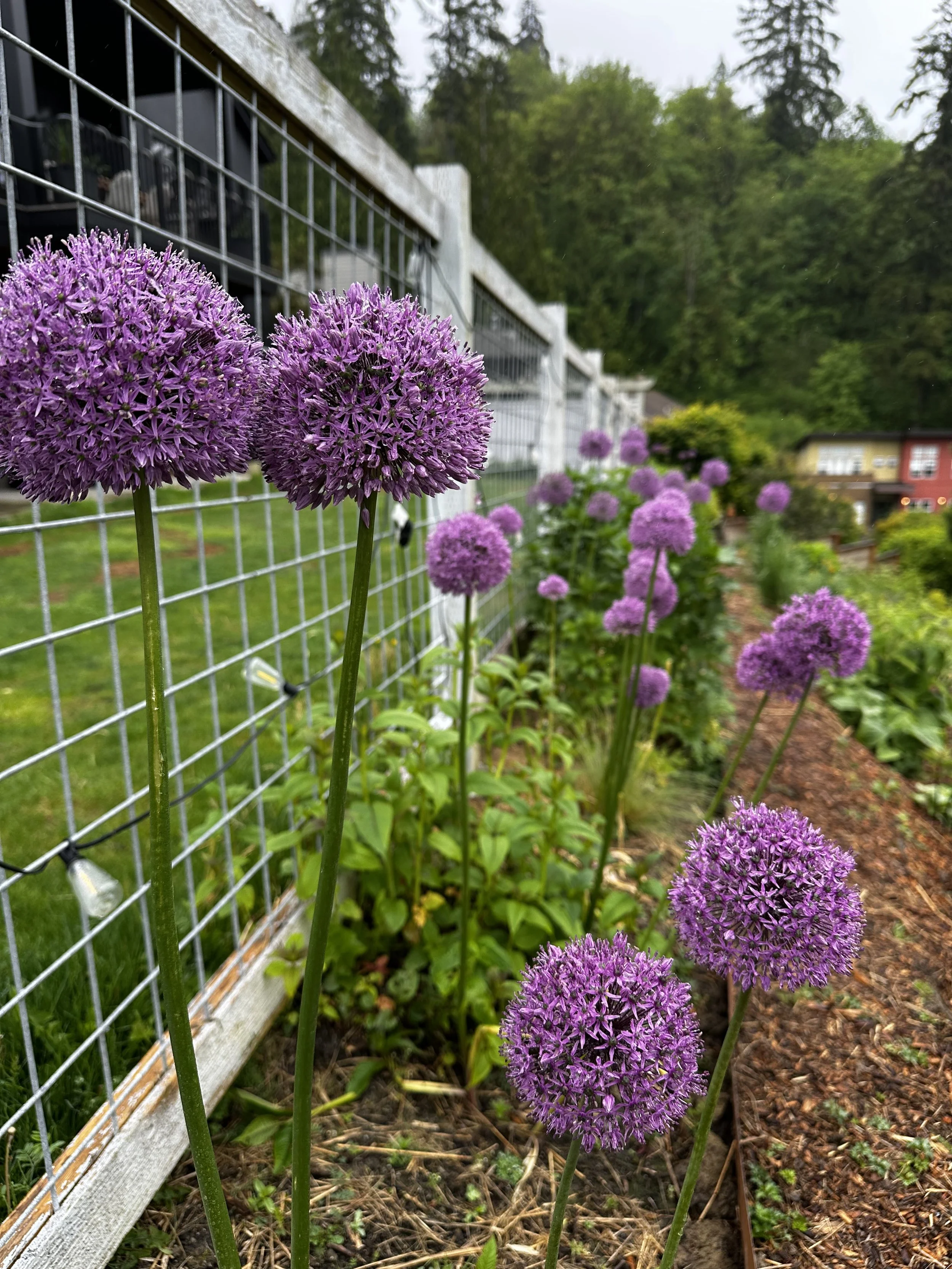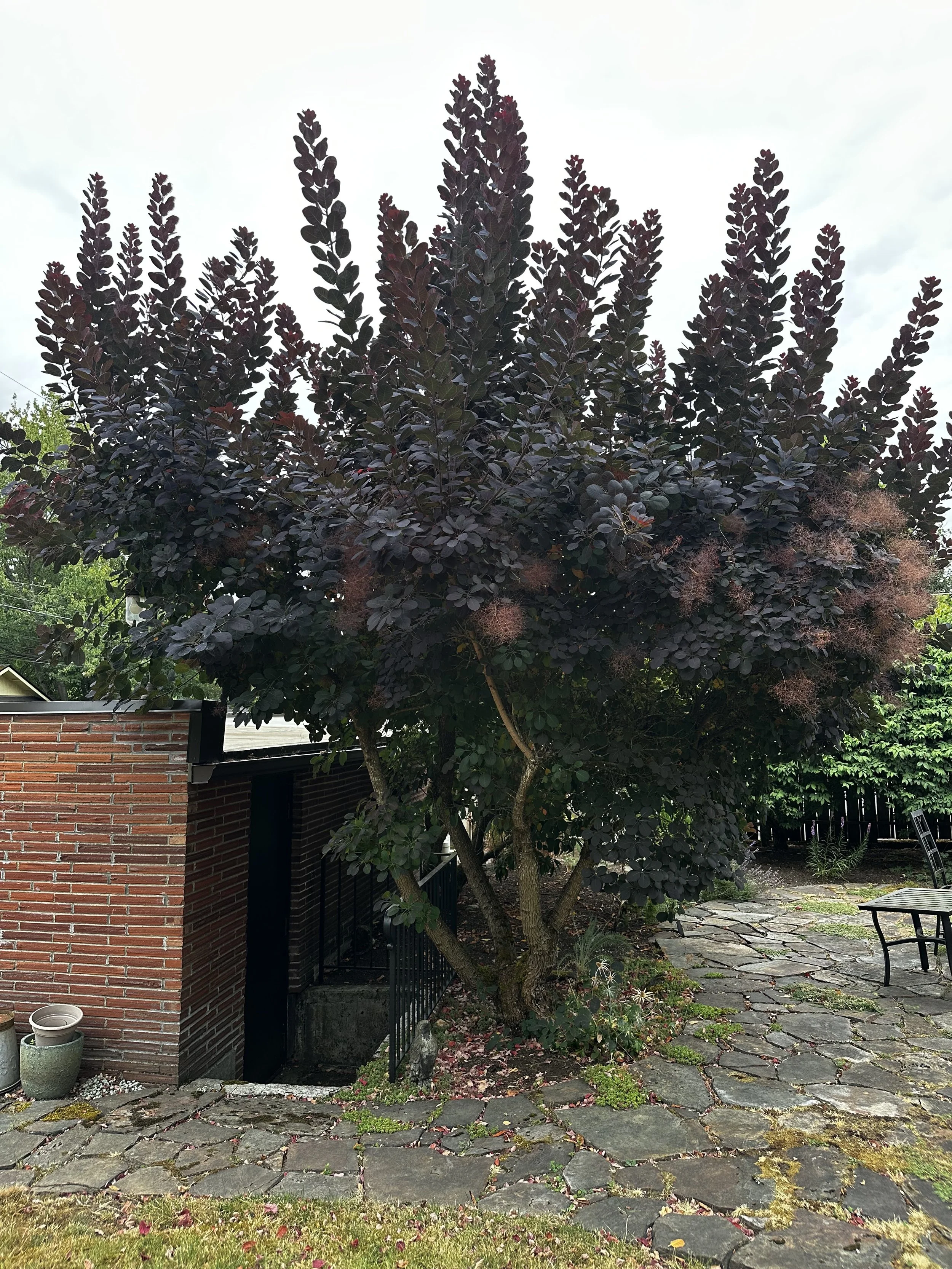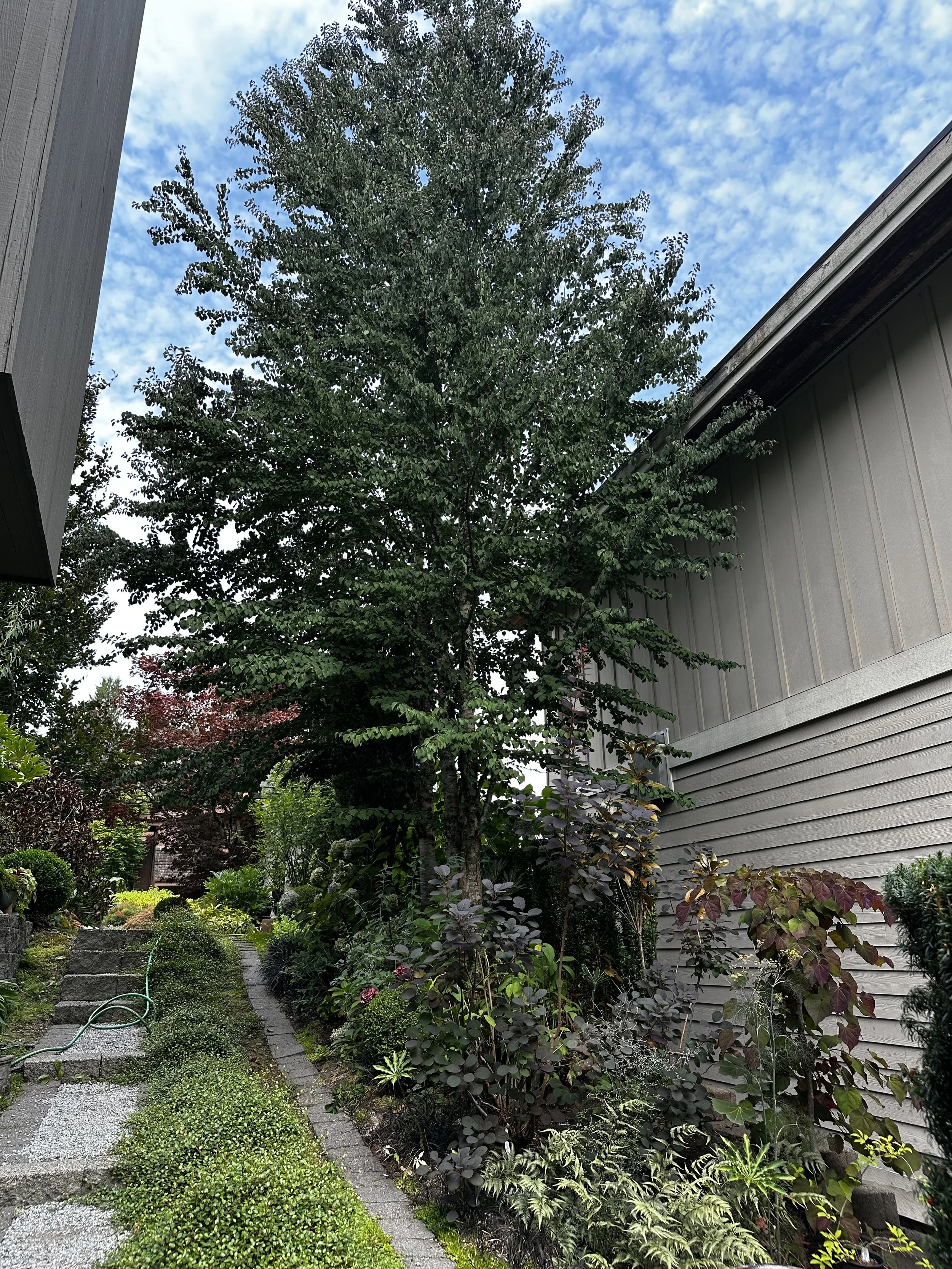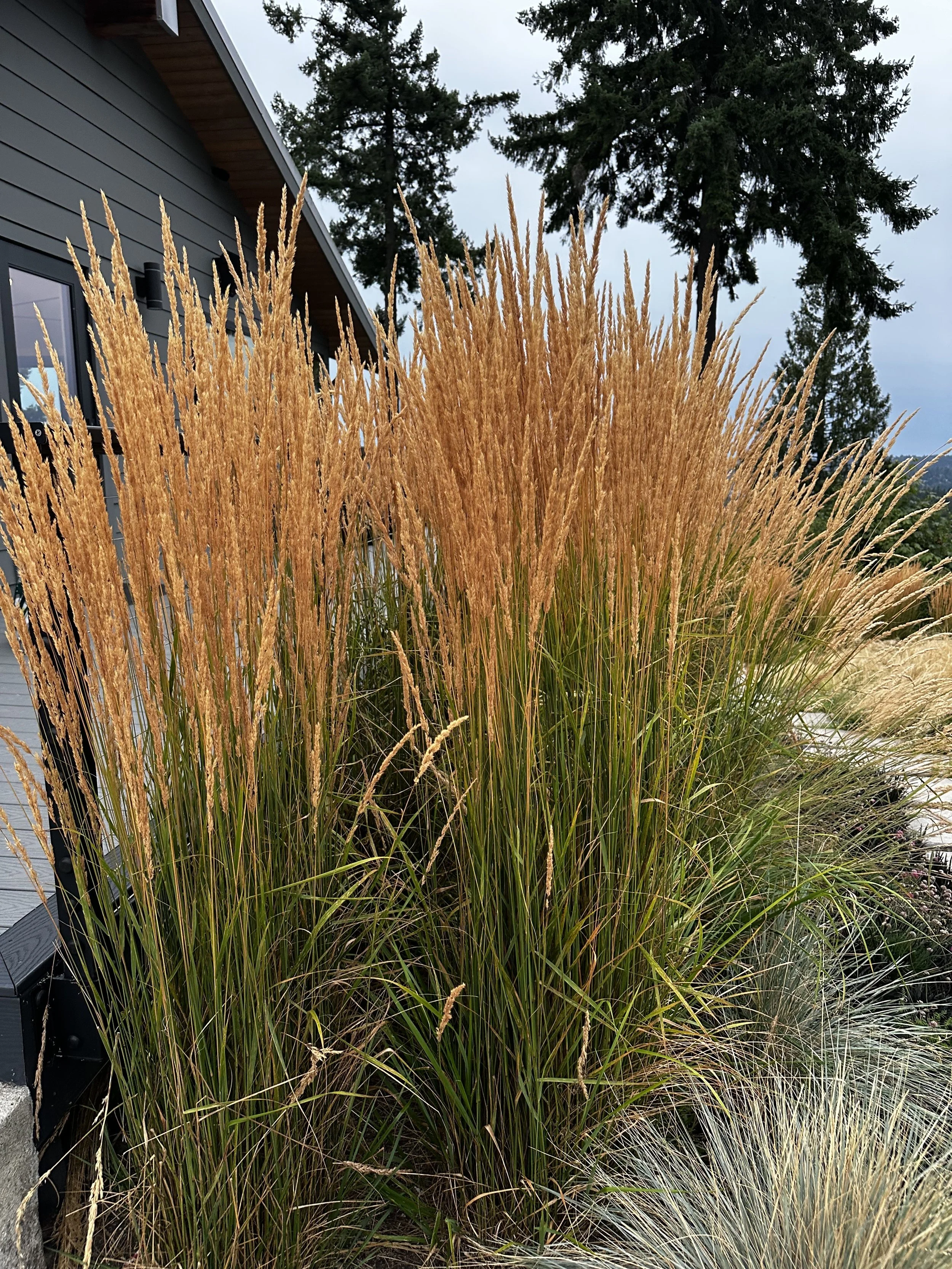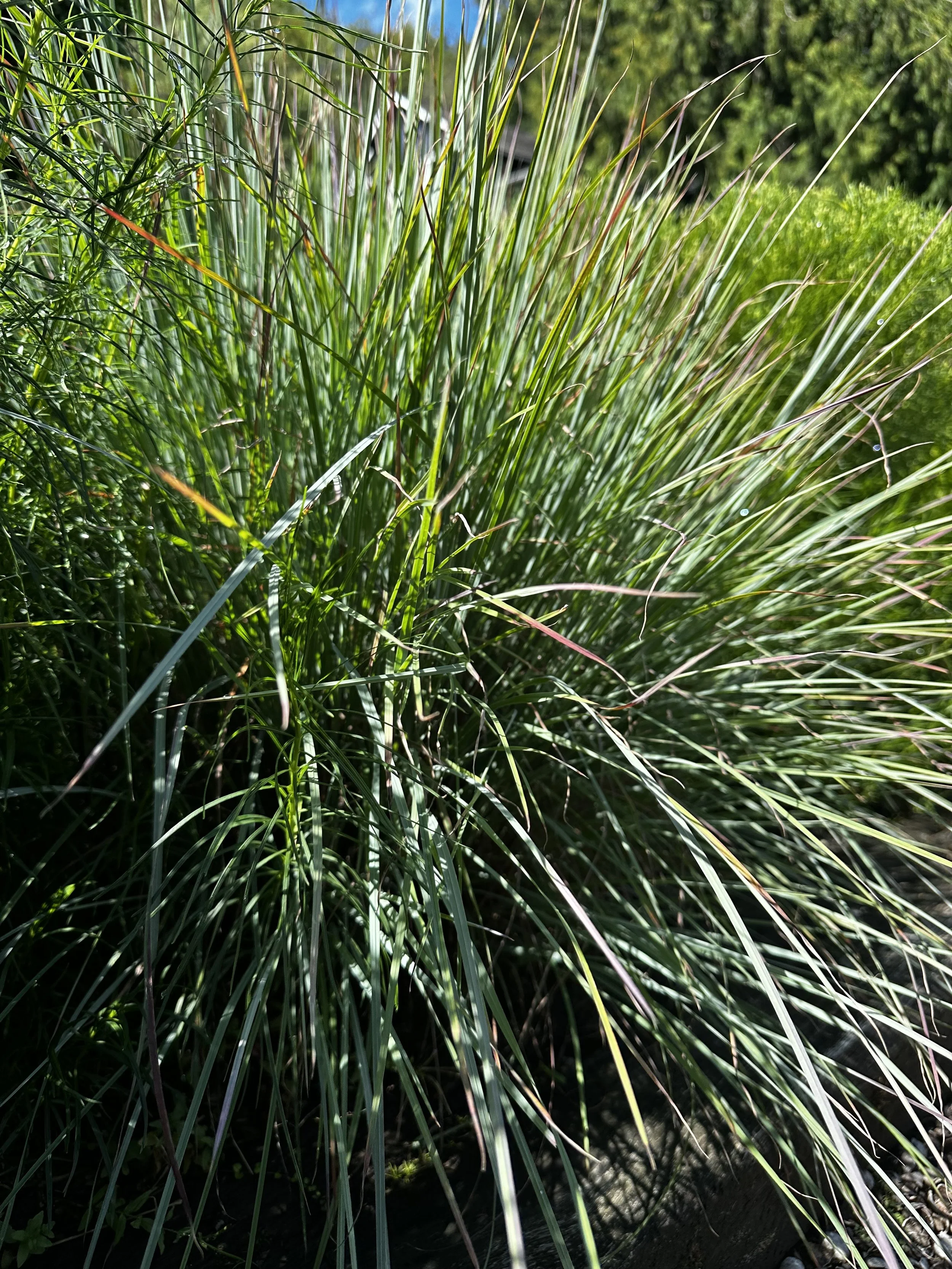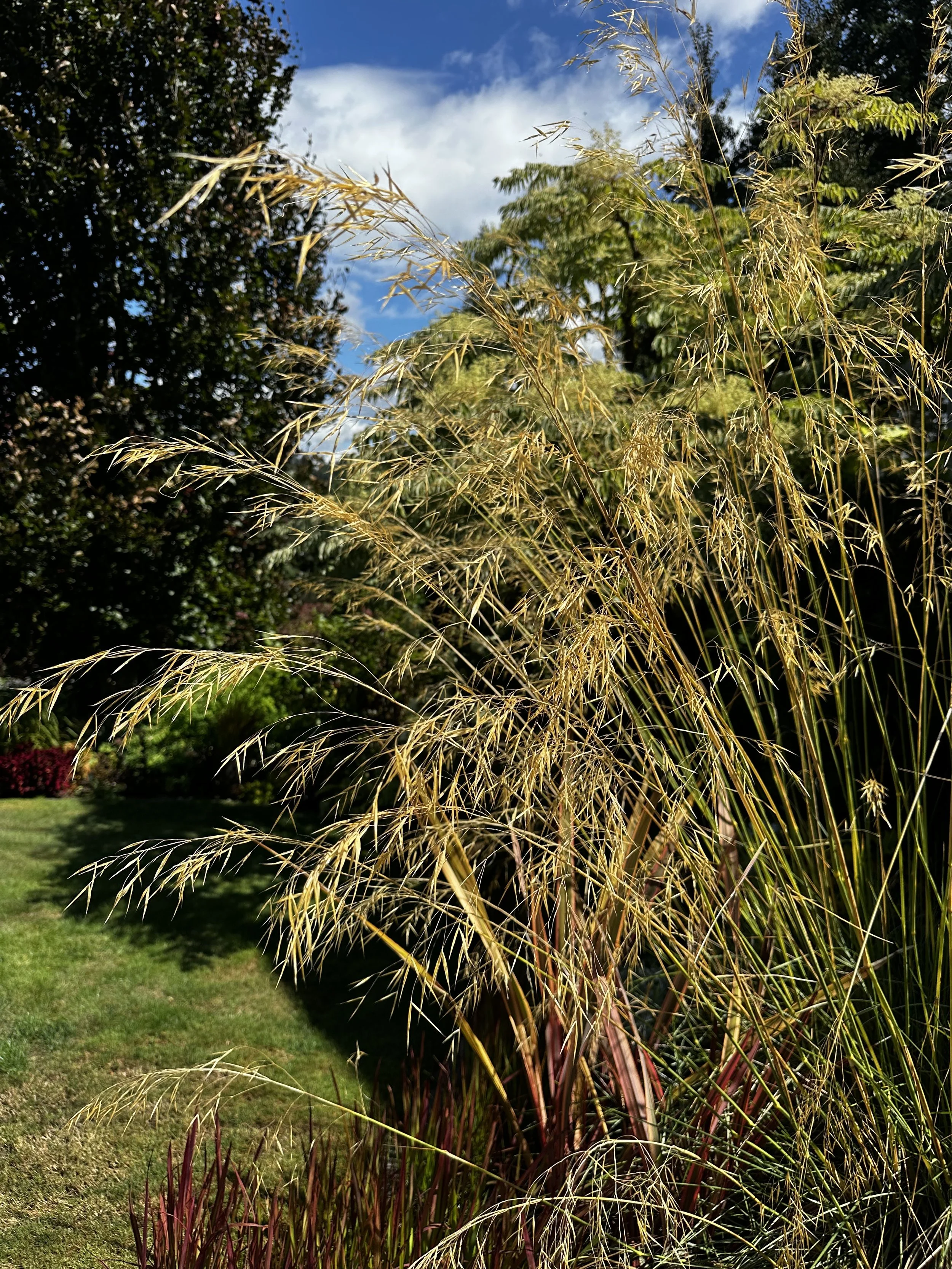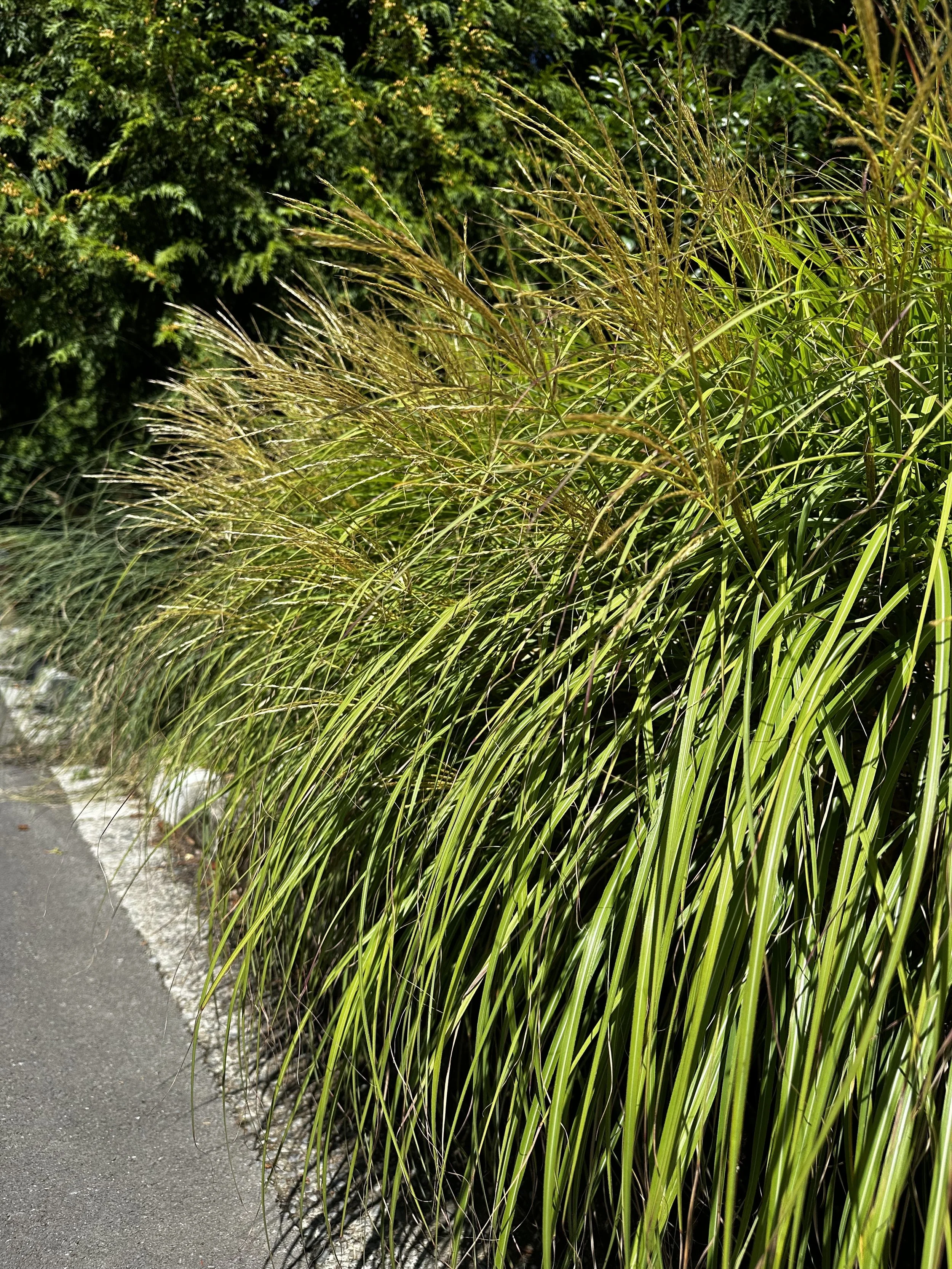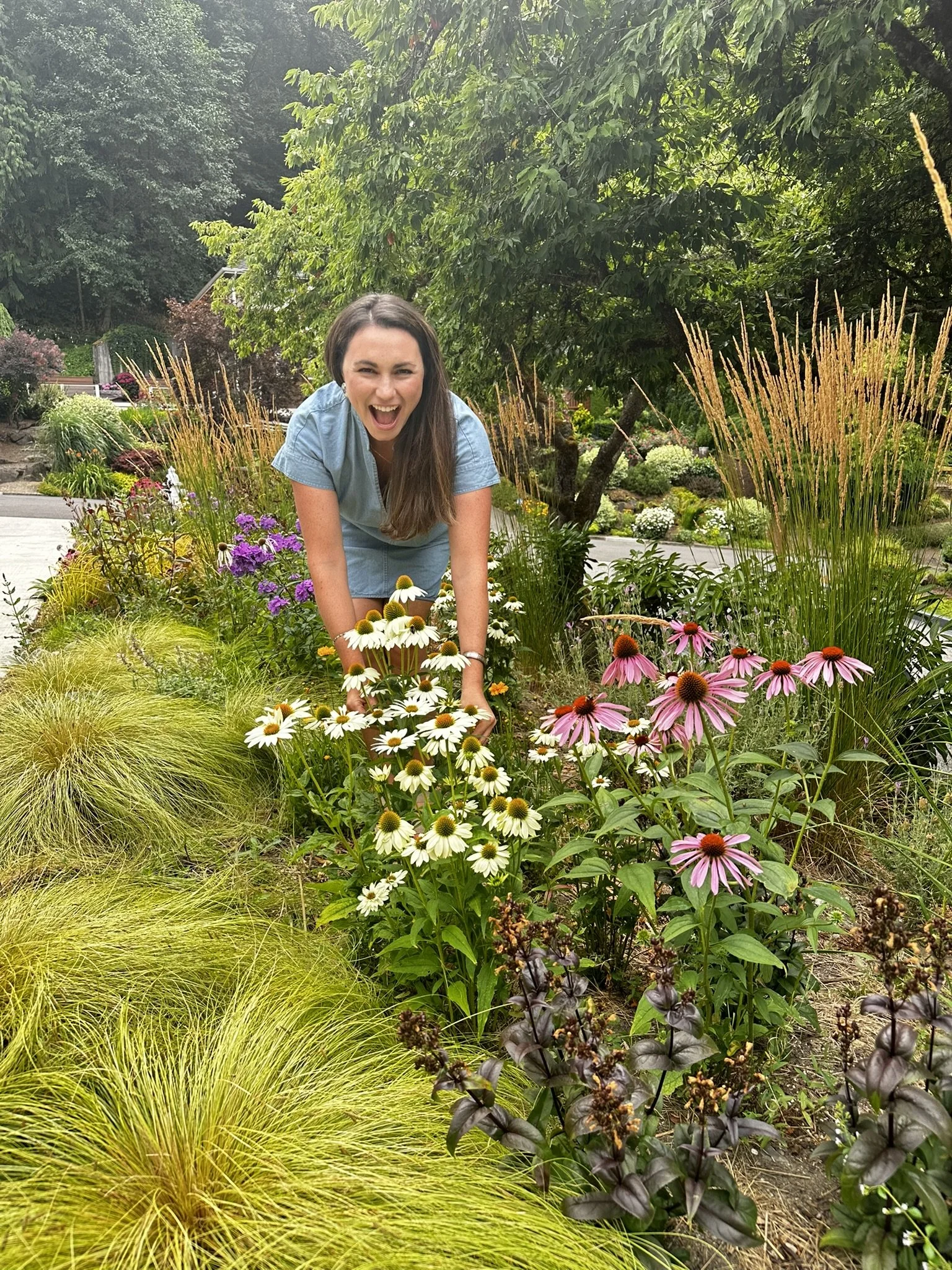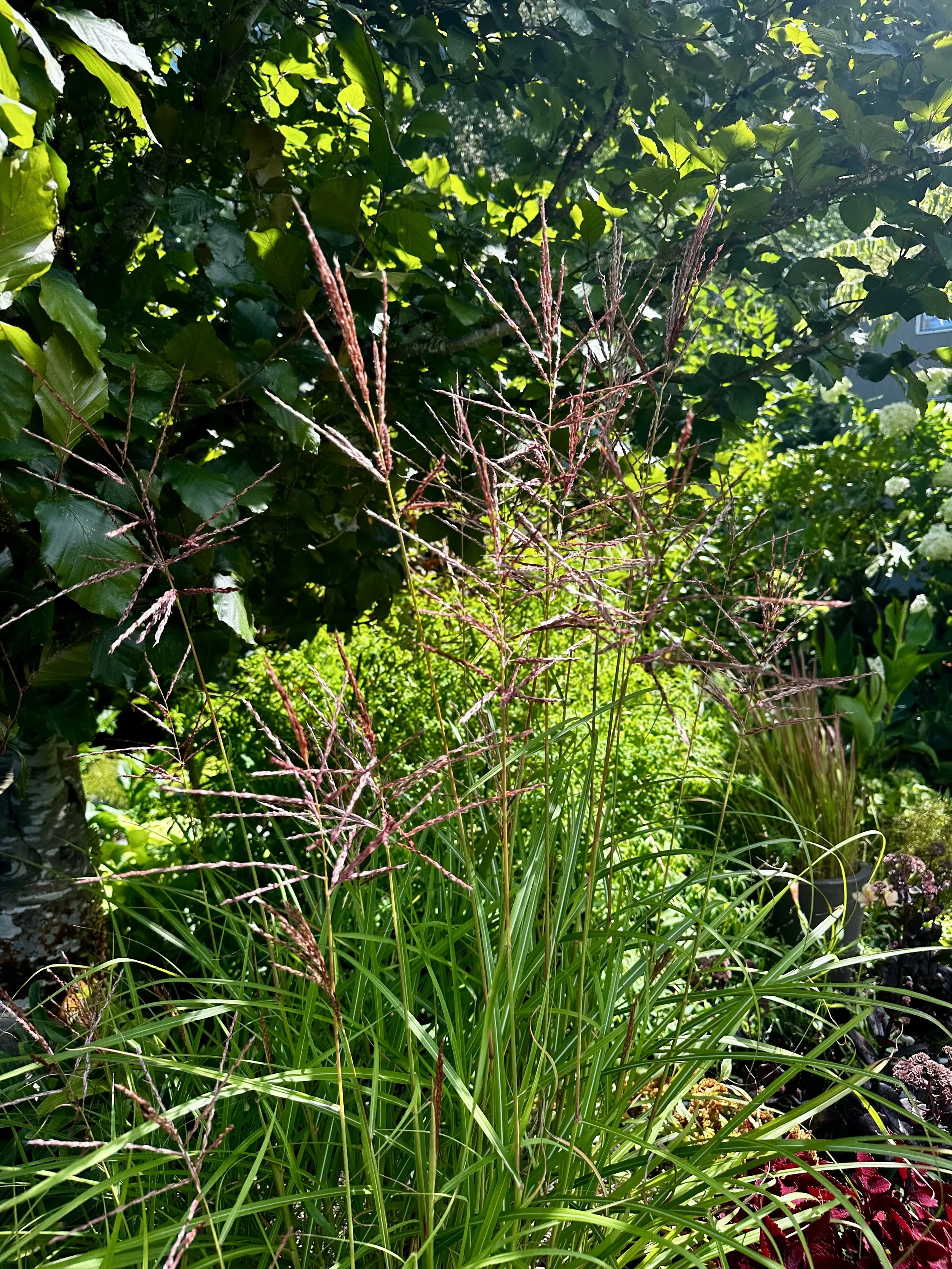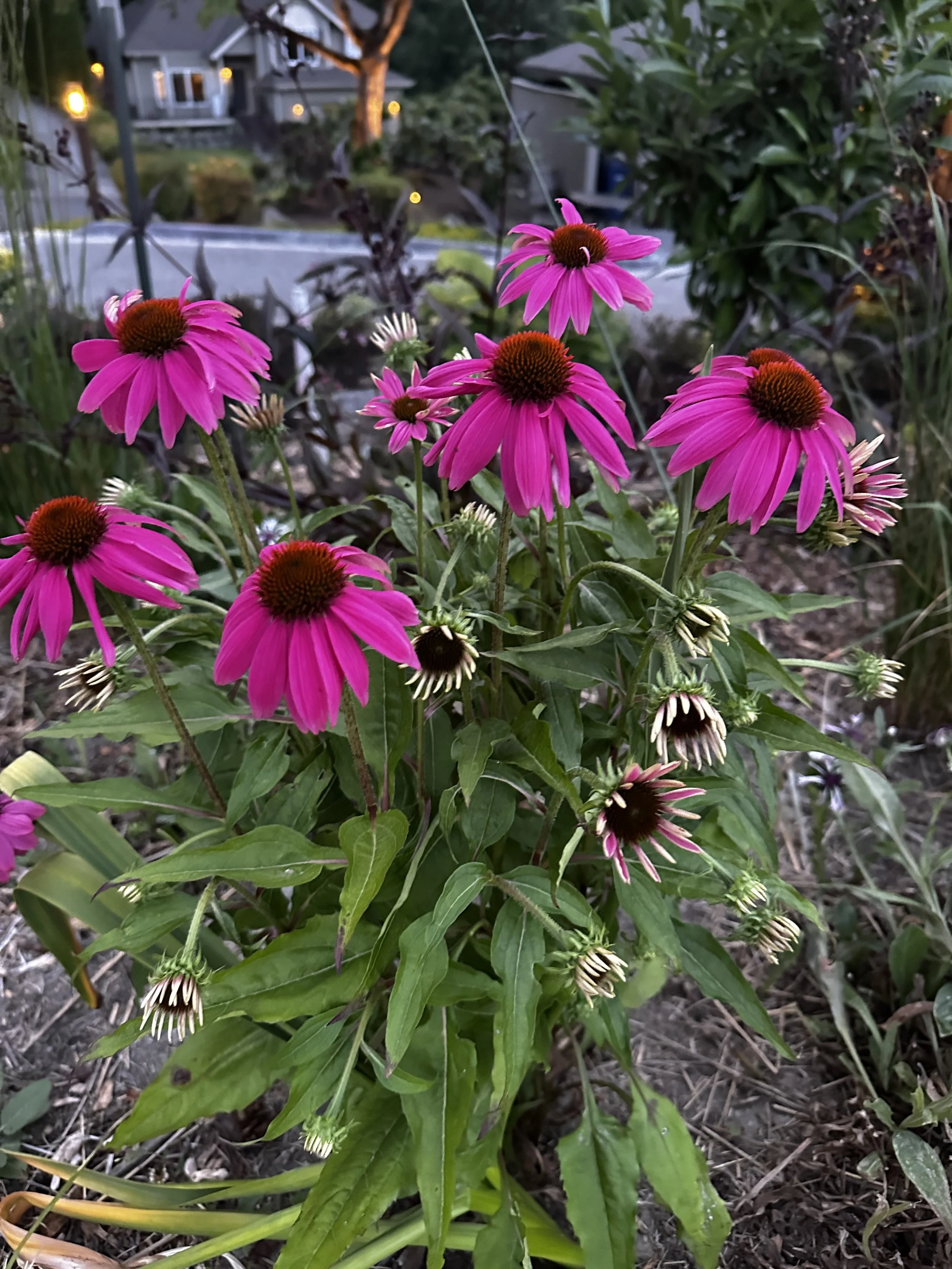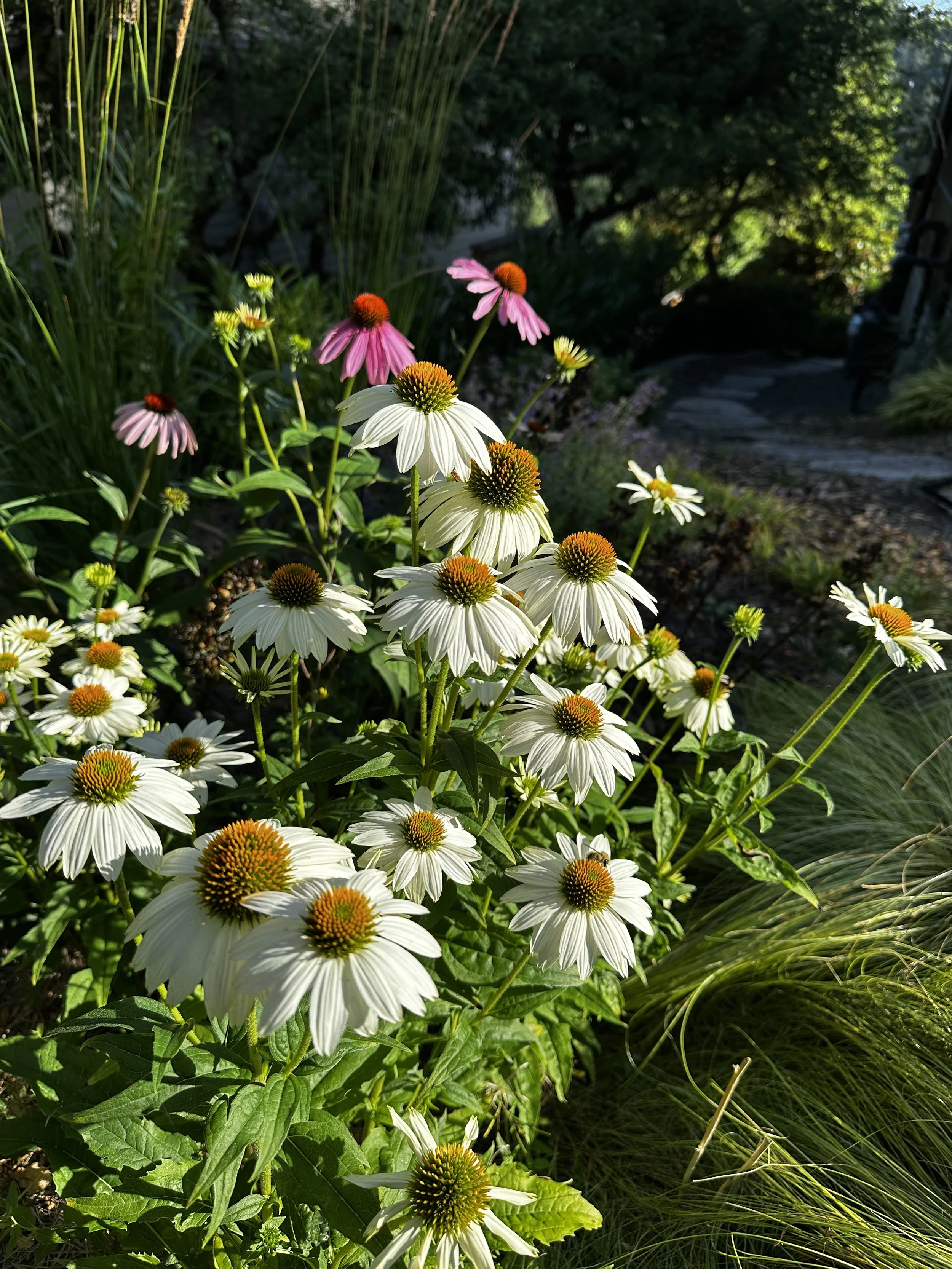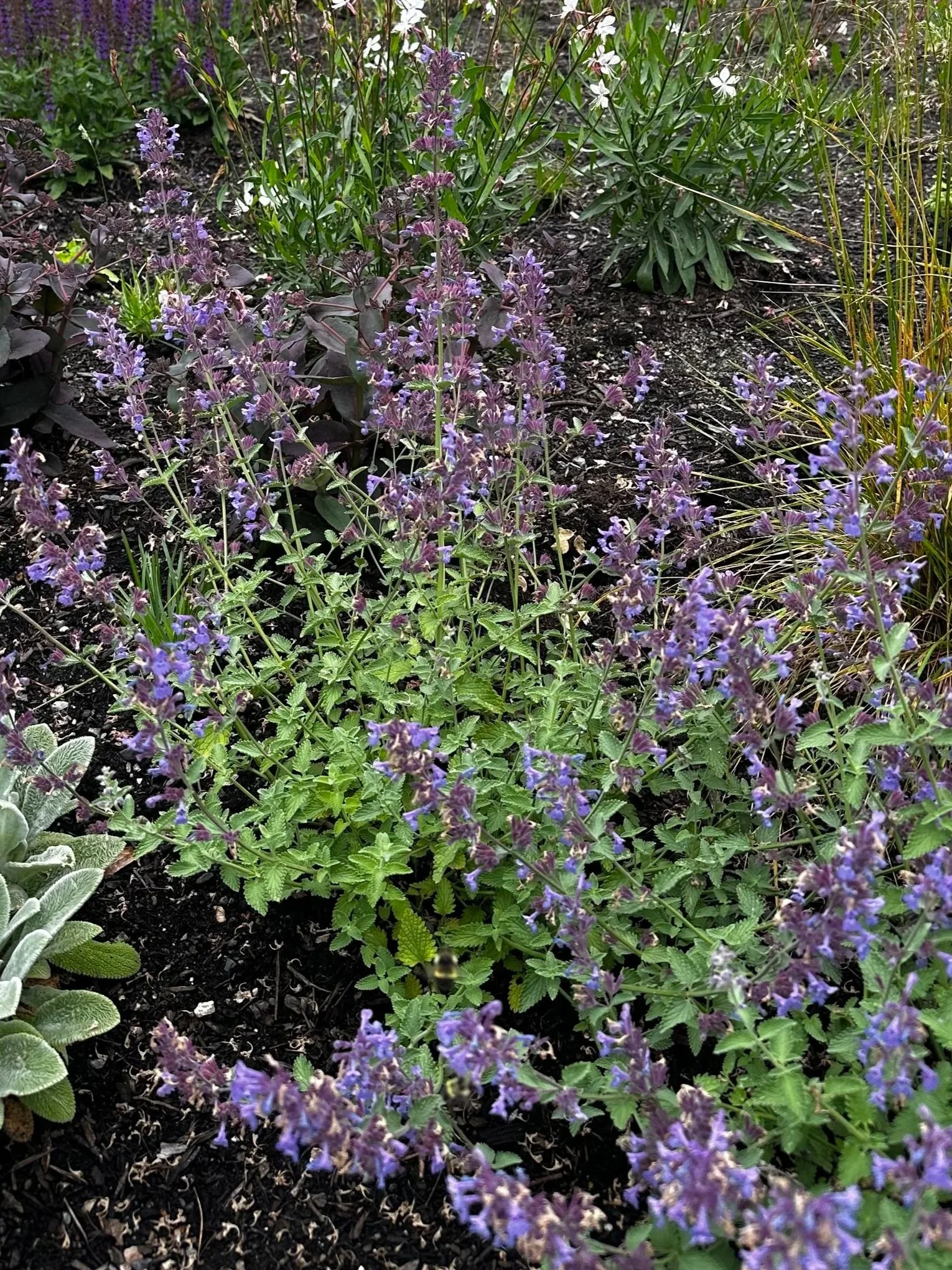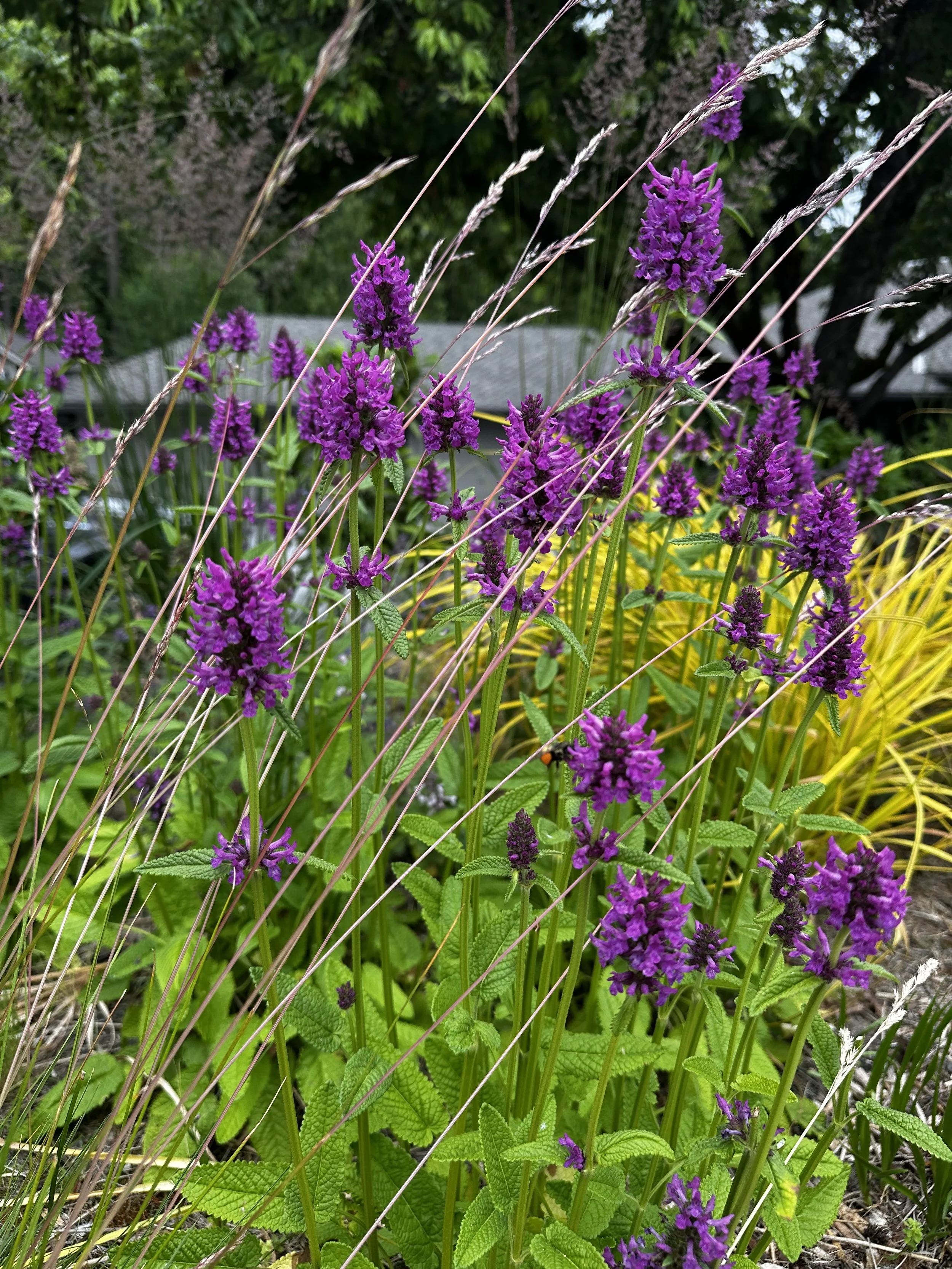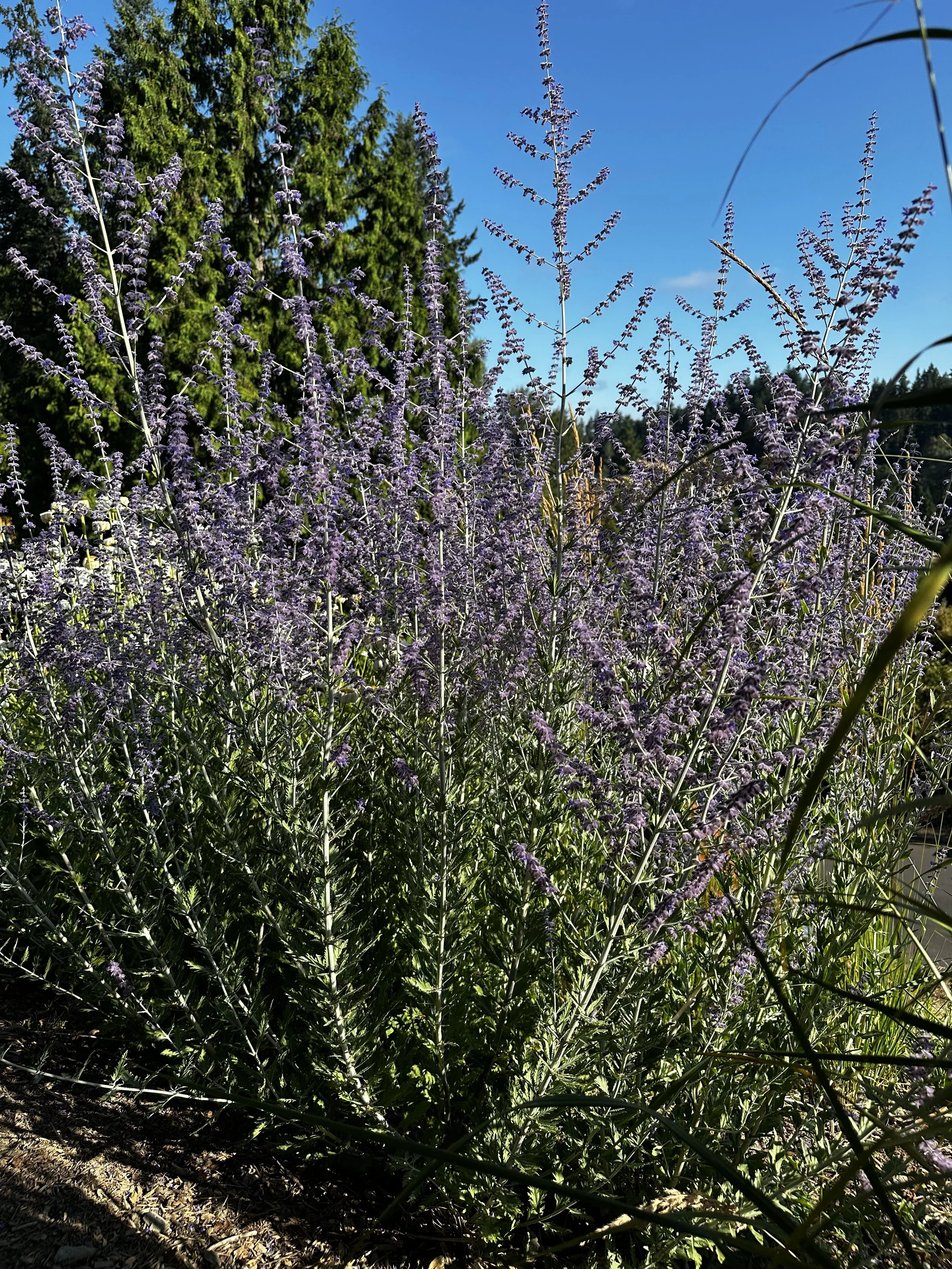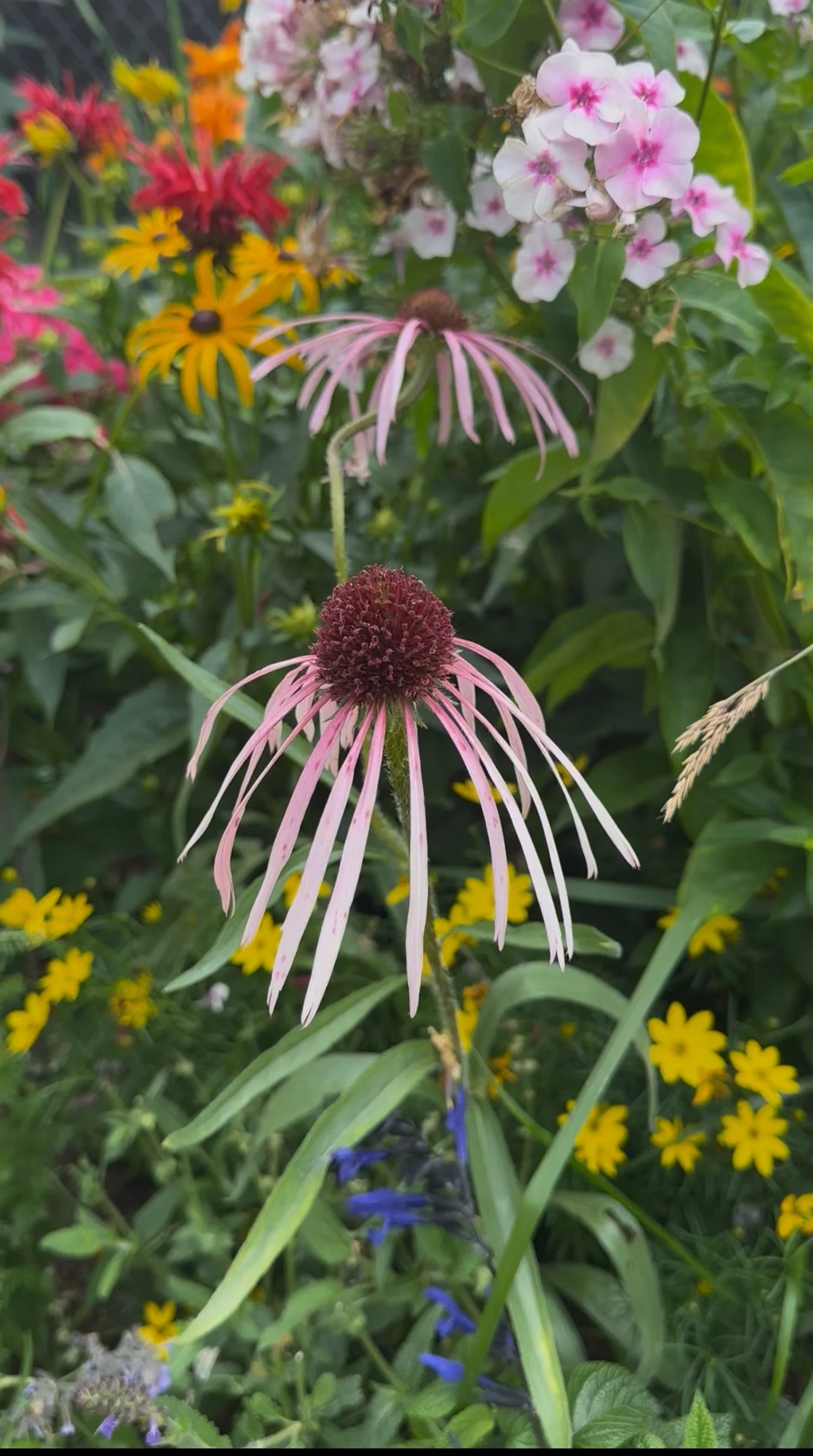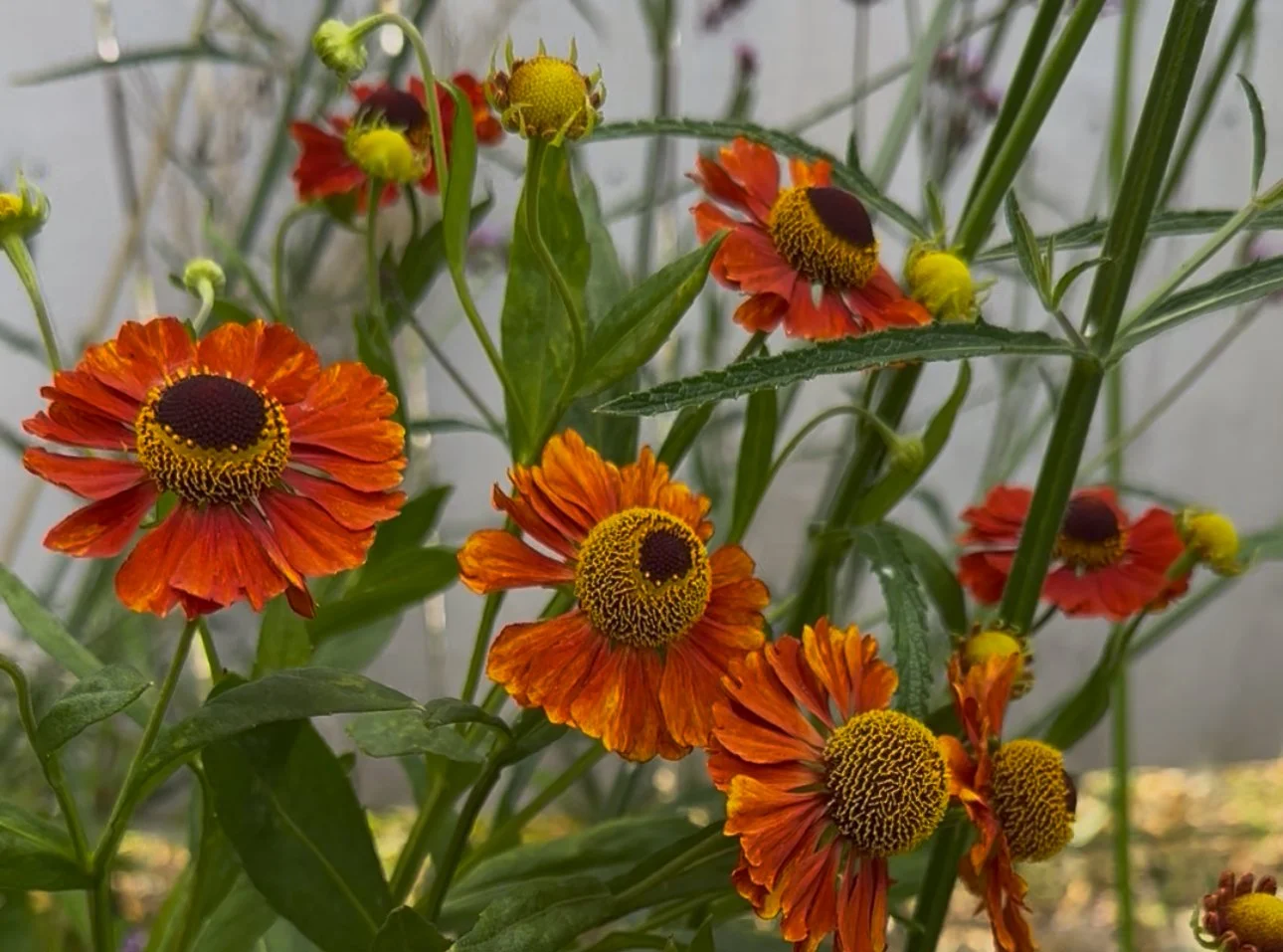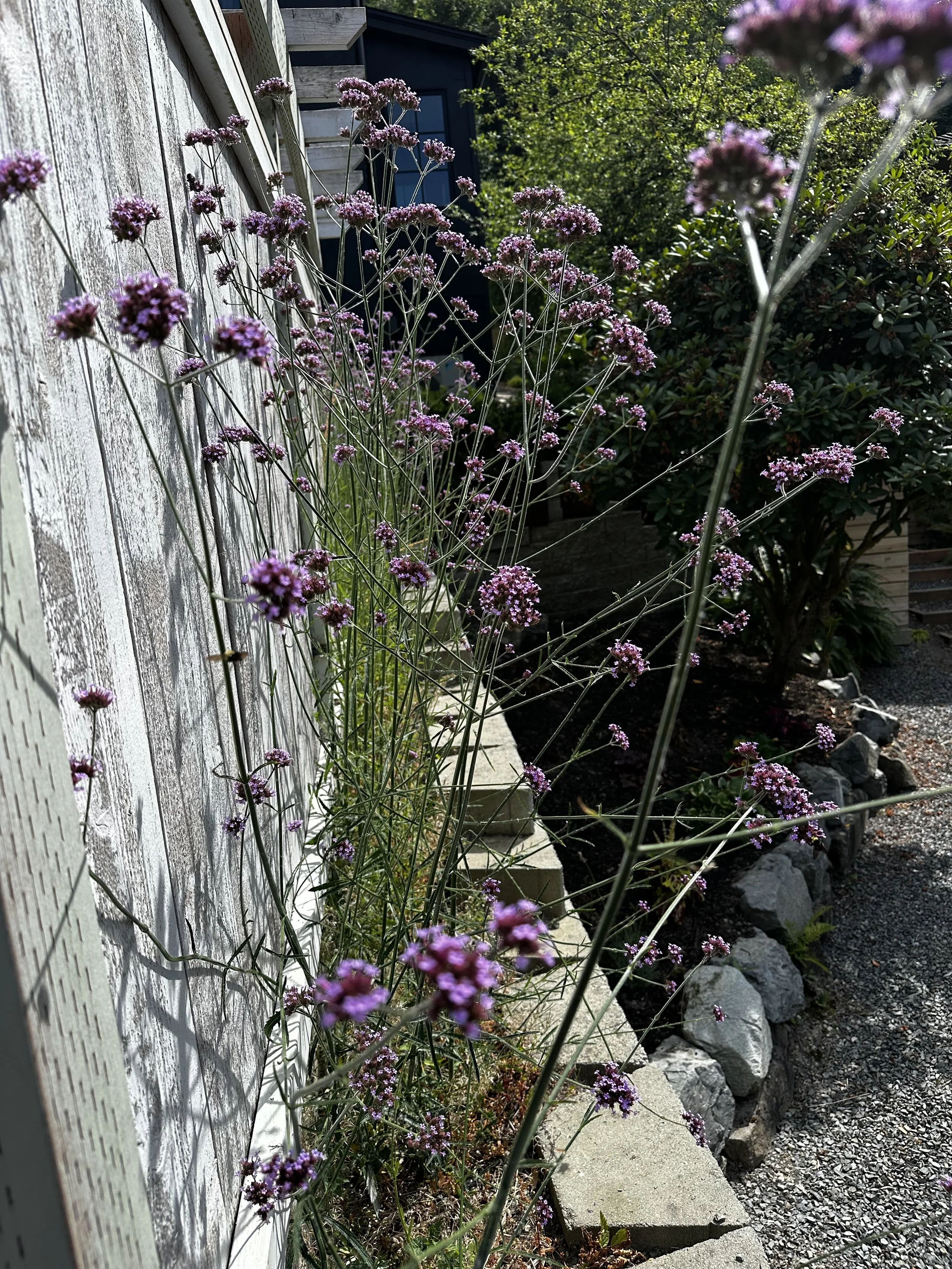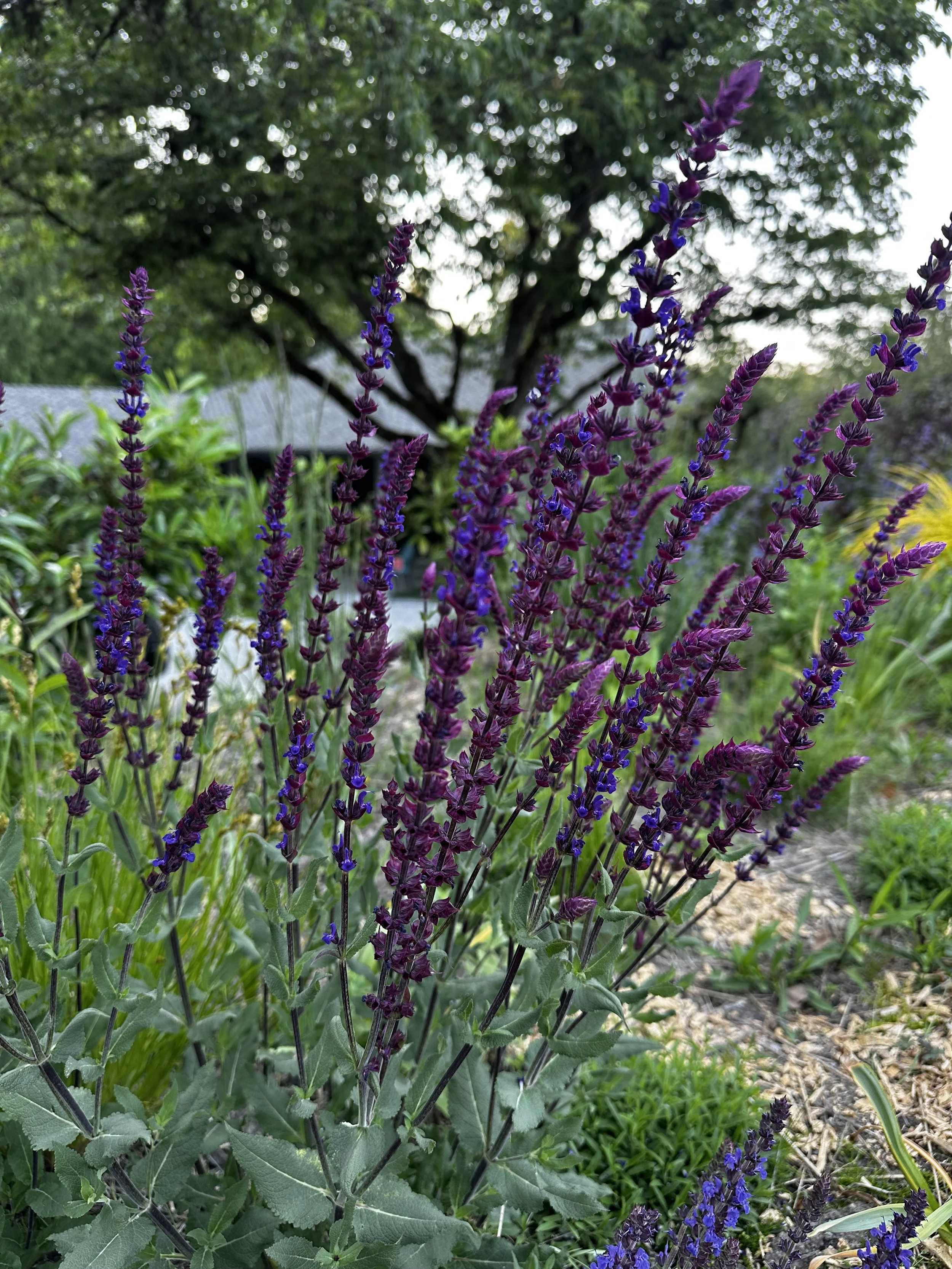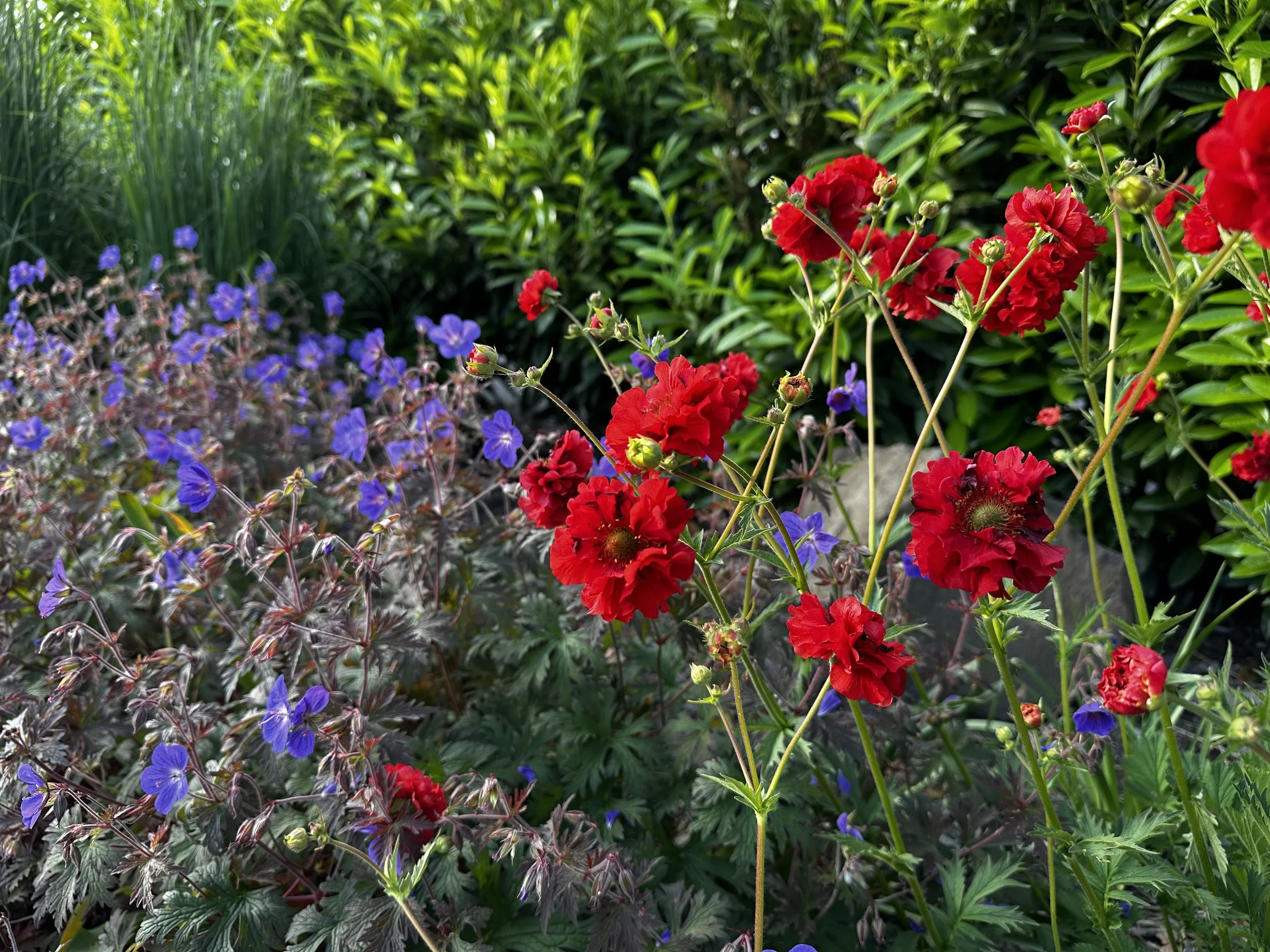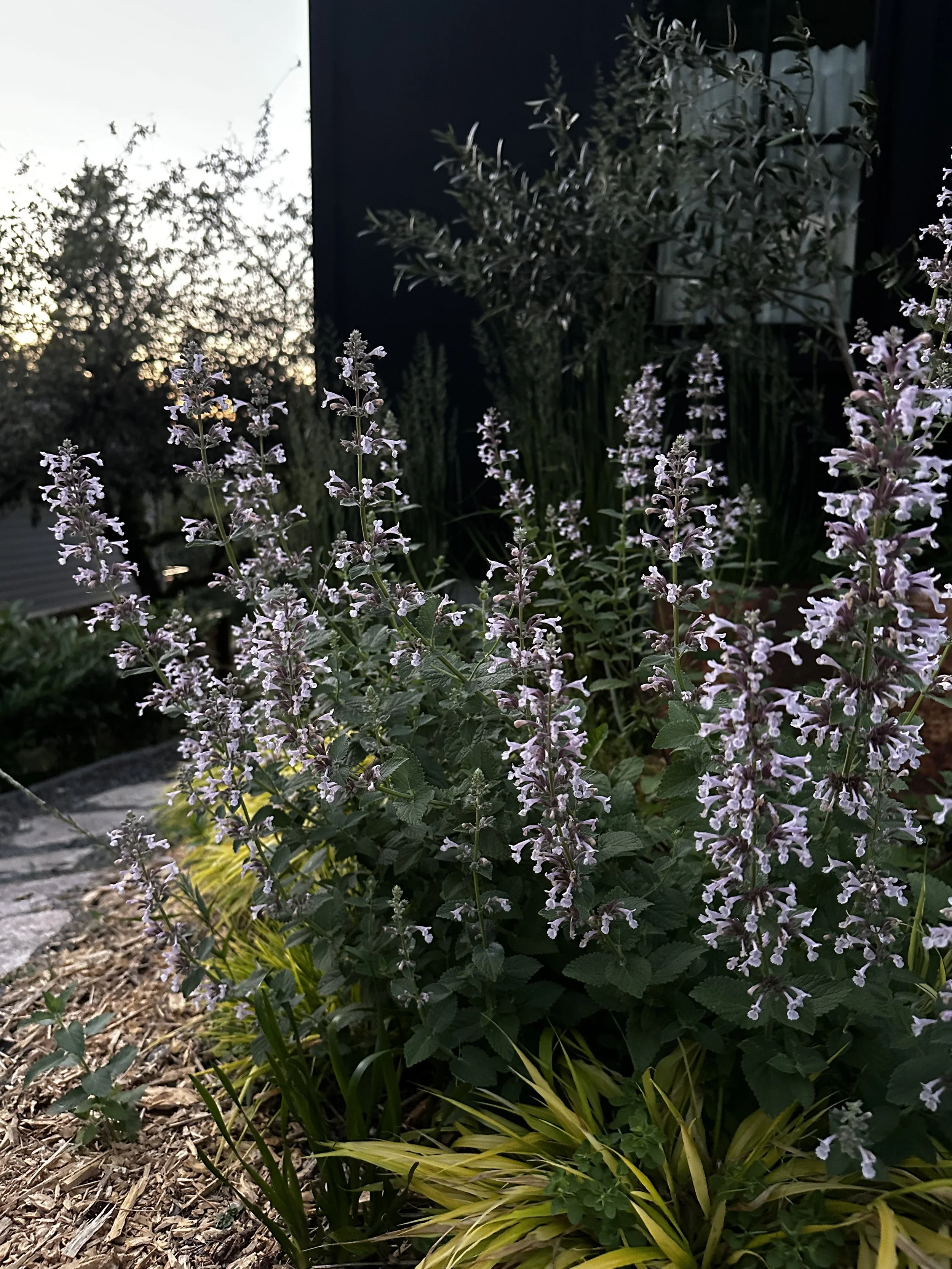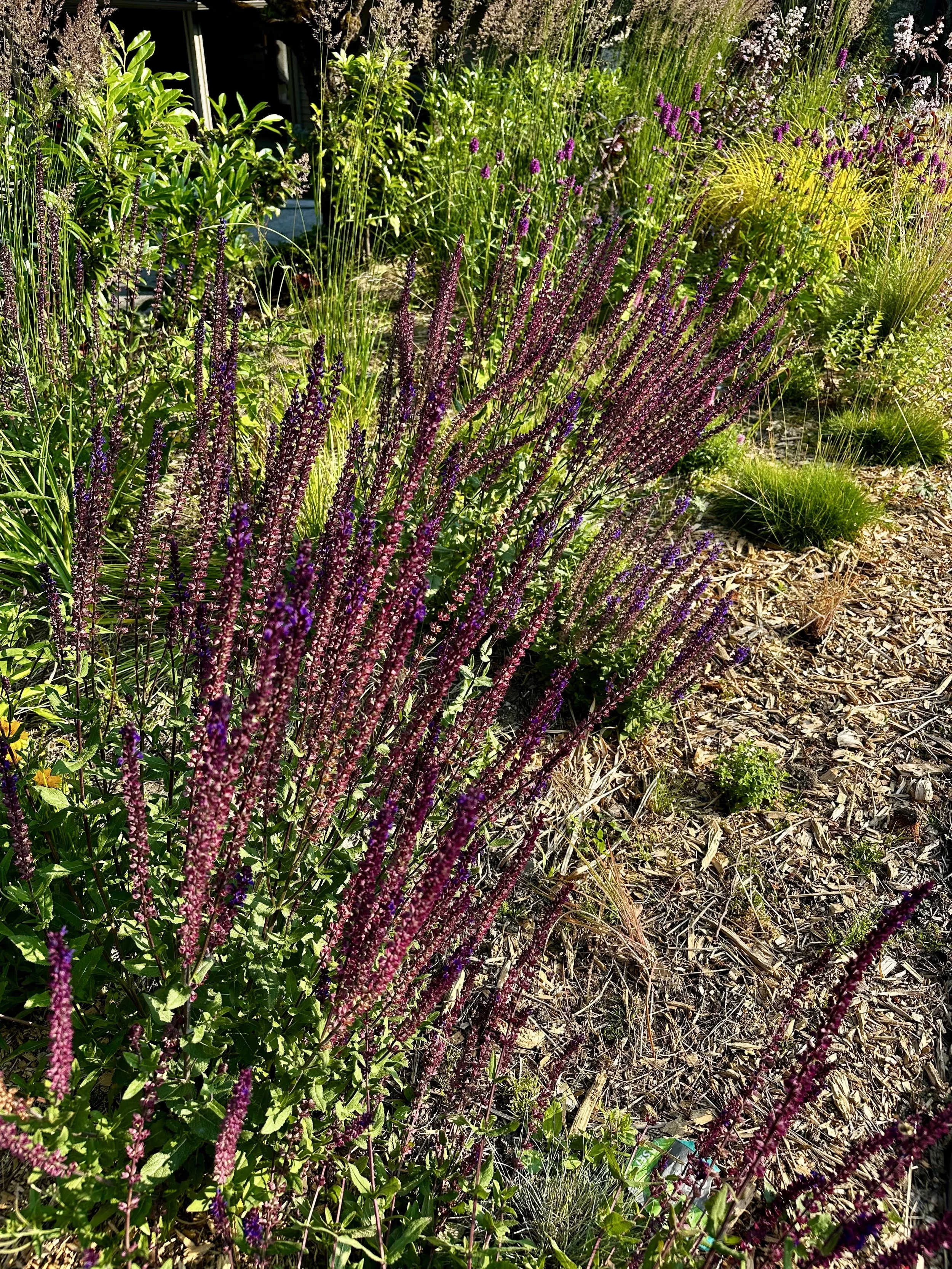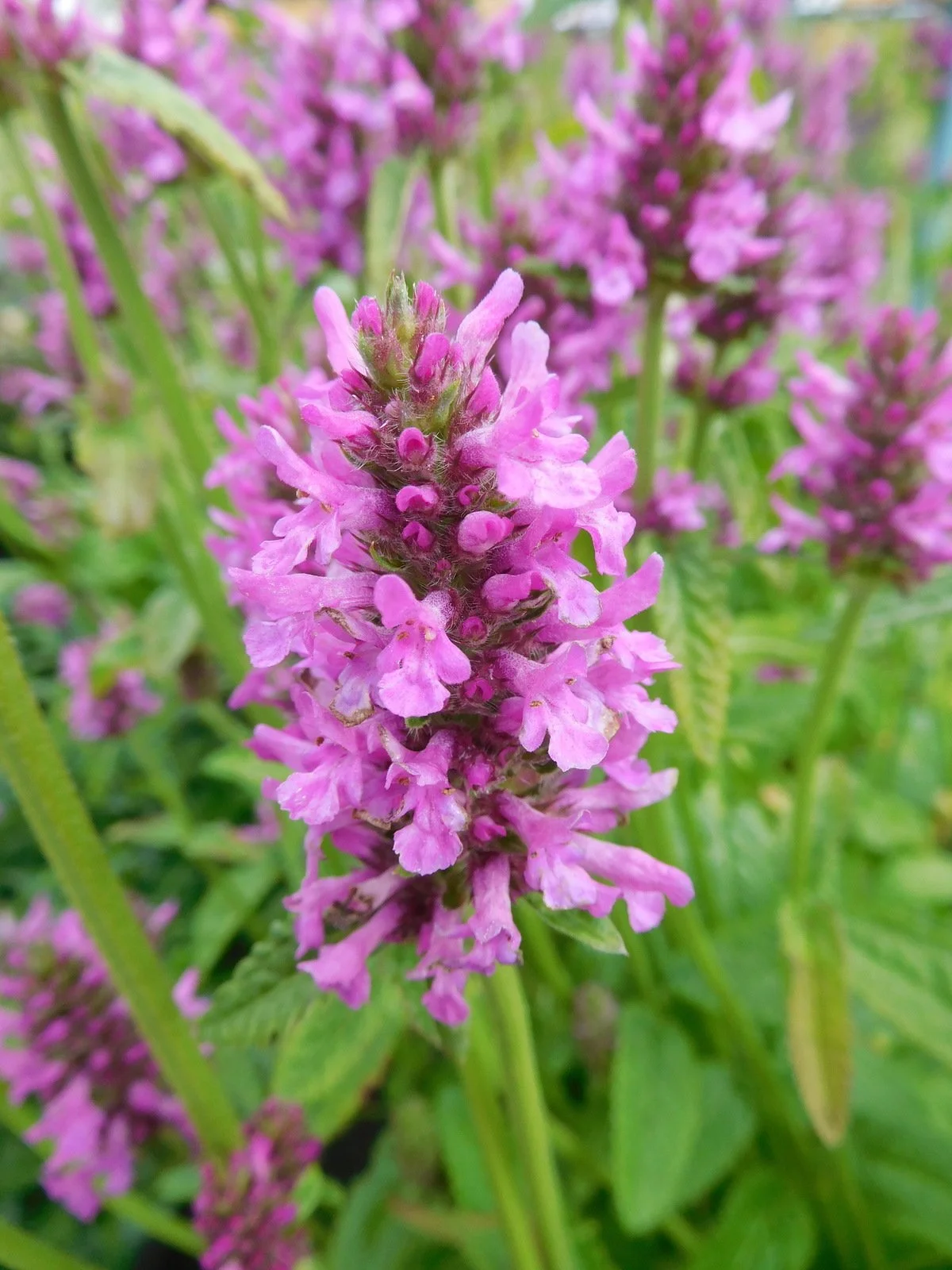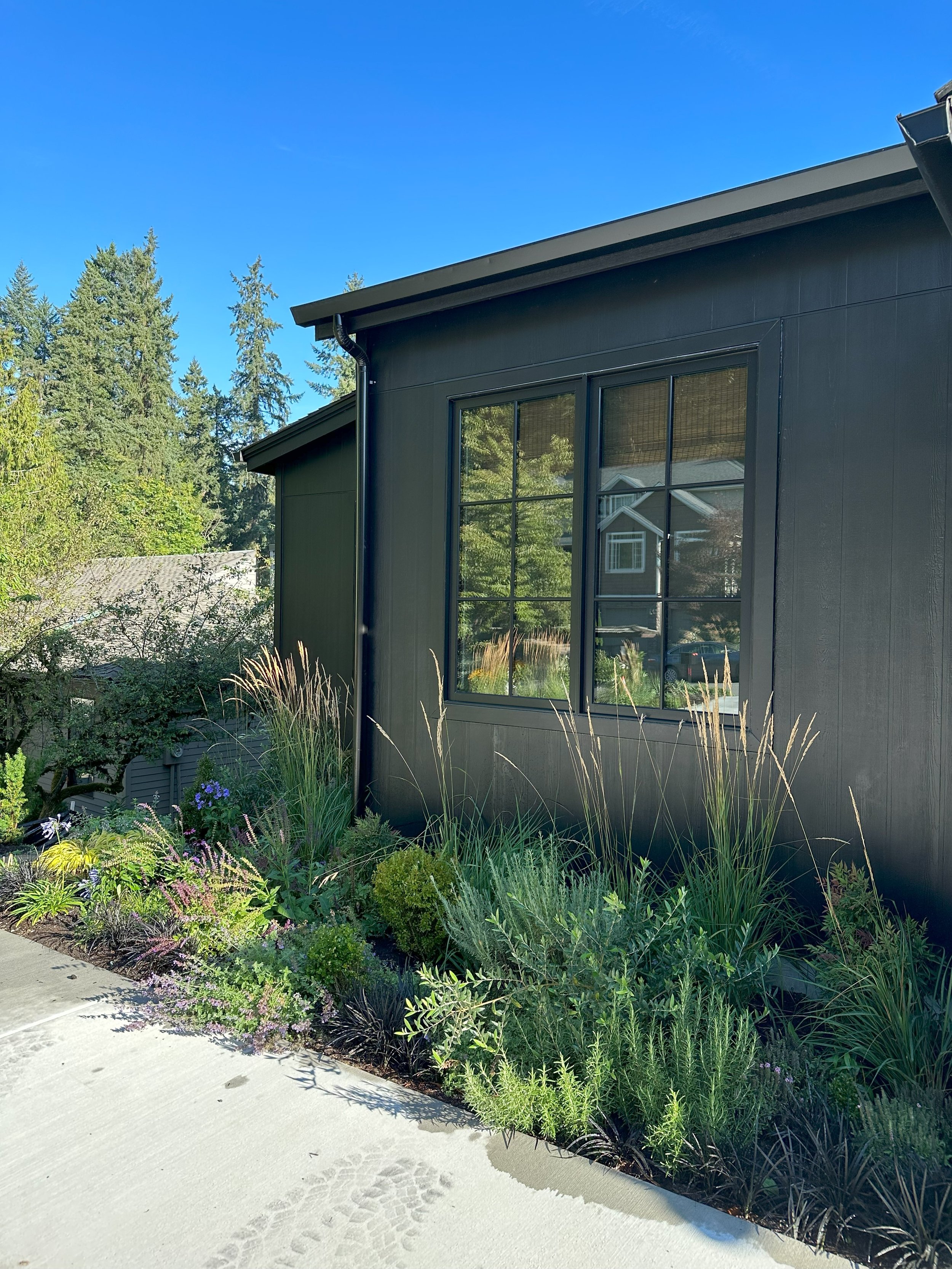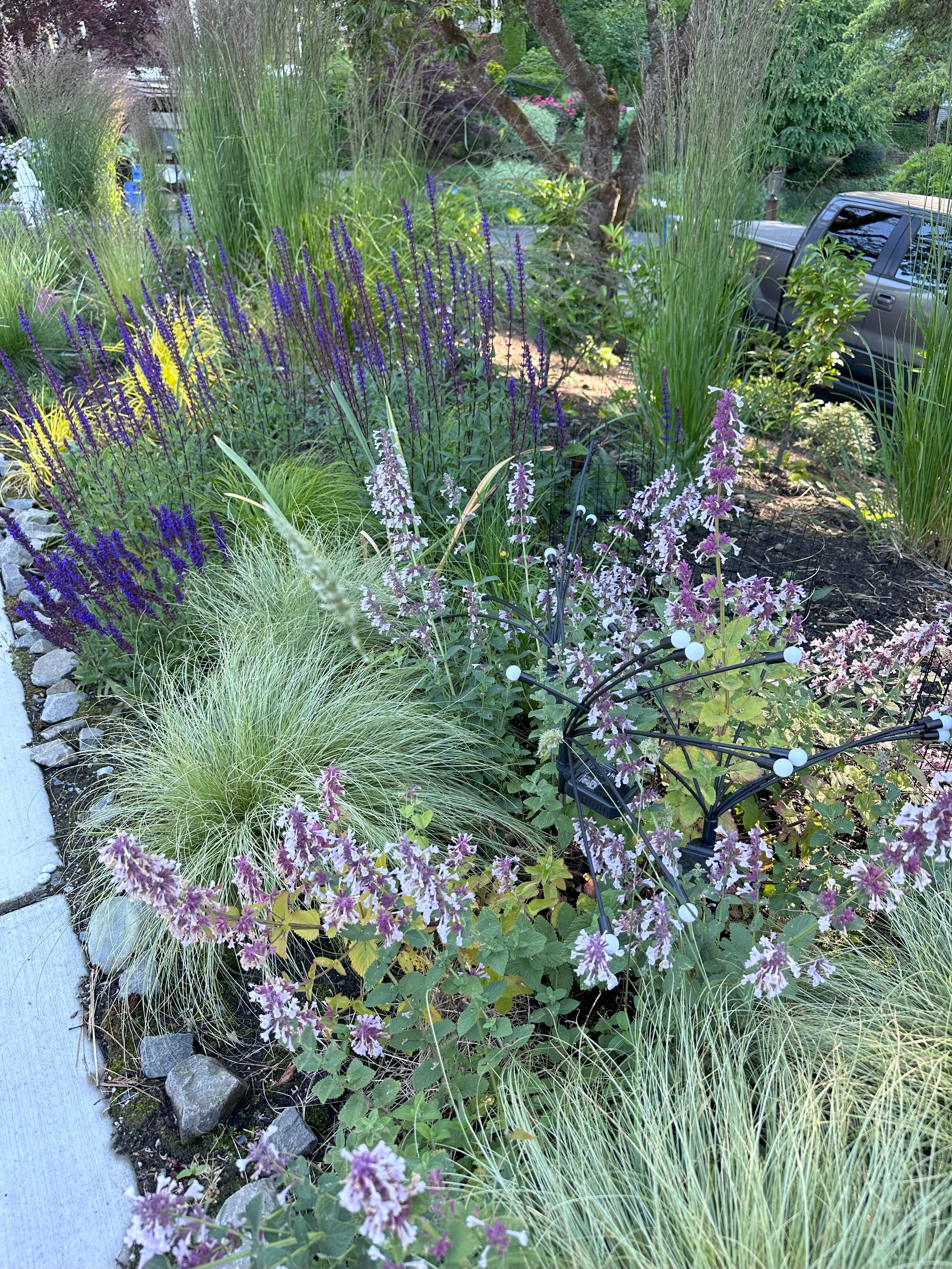🌱 The Ultimate Guide to Fall Bulb Planting
How to Layer, Protect, and Design a Garden That Blooms From March to July
Allium Globemaster
If you’ve followed me on Instagram for even a minute, you already know:
I’m a bulb girl.
Bulbs are the secret to early-season color, seamless transitions into summer, and gardens that feel alive from March through July.
Every fall, I’m planting thousands—literally thousands—of bulbs across Seattle for clients who want naturalistic, Piet-Oudolf-style gardens that wake up early and glow all season long.
Below is everything I’ve shared across reels and captions, pulled together into one complete guide: my entire bulb philosophy, process, tips, tricks, and design rules.
Let’s dig in.
(Grab a bucket… you’ll need it 😉)
🌷 Why Bulbs Matter More Than You Think
When your garden is sleeping in March, bulbs are the only thing blooming.
And that early-season color? It wakes up the entire landscape.
They:
Push through cold soil when nothing else is ready
Feed pollinators in the hungriest months
Bridge the gap between winter interest and spring growth
Give you drama, color, movement, and magic for very little work
A garden without bulbs is a garden missing its heartbeat.
🌼 My Top Tulip Tips (The Viral Ones)
These came straight from your favorite reel—organized here for quick reference:
1. Plant tulips late.
November–December is ideal in the PNW.
Why? Planting too early = fungus, rot, split tips.
Plant when Costco is selling them… then wait 6–8 weeks.
2. Hide the foliage.
Plant tulips inside your borders, not at the front.
Let grasses and perennials cover the fading foliage so you don’t have to stare at yellowing leaves for six weeks.
3. Choose a dominant color (60% rule).
Pick one color family, then layer textures and varieties within that palette.
This is how European gardens look so intentional.
4. Plant tulips + daffodils + alliums together.
Mix tulips and daffs in a bucket, toss across your beds, plant where they land.
Layer alliums in after.
This replicates the naturalistic look you see in Lurie Garden + High Line.
5. Protect your tulips.
Surround them with alliums (onion scent = critter repellent) and daffodils (texture they avoid).
Add rose stem clippings around the planting holes if squirrels are extra spicy.
🌼 Daffodils: The Underrated Heroes of March
Daffodils are the first true color in the garden.
They come back every year, multiply, and are deer + bunny resistant.
My must-grow varieties:
St. Patrick’s Day — chartreuse tones that glow in late winter
Replete — romantic double salmon-pink petals
Dutch Master — classic golden trumpets
Plant them deep. Plant a lot. Plant them everywhere.
🧅 Alliums: The Sculptural Stars of May & June
If you want a naturalistic garden, you need alliums. Full stop.
Here’s how I use them in designs:
Allium ‘Mount Everest’
Tall white globes — perfect along a path or rising above spring borders.
Allium ‘Purple Rain’
Mass plant these in groupings for color washes through the borders.
They float like purple fireworks.
Allium ‘Schubertii’
The statement allium.
Use in pots, in front garden beds, or as a sculptural focal point.
Allium ‘Drumstick’
Scatter them everywhere.
Let them pop up in surprising places among perennials and grasses.
Alliums are also:
Critter resistant
Drought tolerant
Incredible dried seed heads for summer interest
🪺 Protecting Your Bulbs From Critters
Every year we go to battle:
Crows. Squirrels. Rabbits. And the occasional very motivated raccoon.
My protection plan:
Lay netting over newly planted beds
Use temporary scarecrows for the first 10–14 days
Cover beds with leaves (nature's blanket)
Plant alliums + daffs around vulnerable tulips
Add rose stem cuttings as a natural perimeter
Once your bulbs are rooted and settled, you can remove the netting and relax.
🌱 My Exact Bulb-Planting Process
(How I install thousands of bulbs efficiently for clients)
1. Start with design zones.
Spring color should feel like it’s moving through the garden—never randomly placed.
2. Mix bulbs in buckets.
This prevents patterns and gives a natural scatter that feels effortless.
3. Toss the mix across the beds.
Where they land is where they go.
This is how you avoid stiff, overly planned designs.
4. Plant shallow → plant deep.
The rule of thumb is to plant each bulb 3x it’s size. Some daffodils, tulips and alliums are smaller and some are larger- so you want to plant them based on their size. I dig trenches and holes, placing the larger bulbs deeper and in the center and then the rest on the size. I try to avoid having the bulbs touch- then I usually fill the hole with new potting soil. This also helps your overall garden bed to be less compact- allowing perennials and grass roots to grow larger and deeper roots.
5. Top-dress with compost and leaves.
Both feed the soil and protect the bulbs.
🌸 Why a LOT of Bulbs = Impact
A handful of tulips won’t change your garden.
But hundreds planted through your borders?
Game-changing.
This is how professional gardens feel magical:
Big groupings
Repeated colors
Repeated forms
Strong early-season movement
Bulbs nestled inside perennials and grasses, not lined up at the front
If you think you bought enough bulbs…
Double it. 😉
💡 Final Thoughts: Your Spring Starts Now
Fall bulb planting is the most rewarding “slow burn” garden task you can do.
You plant now, in the cold, in the rain…
And in March your garden thanks you with color, life, fragrance, and a sense of renewal nothing else can replicate.
Your spring garden starts today.
And if you need help designing, placing, or sourcing bulbs, you know where to find me.
Book a consultation:
https://www.shanellerabichev.com/consultation
🌳 Caring for Iconic Landscape Trees with Davey Tree
Whether you’re designing a garden oasis or preserving a historic estate, trees and shrubs are the backbone of timeless landscapes. Davey Tree Expert Company, the oldest tree-care firm in North America, has been helping homeowners and communities nurture these living treasures since 1880. Below are ten standout trees and shrubs — their beauty, care needs, how professional arborists maintain them, and ideas for how to place them in your garden design.
{Sponsored Post}
1. Silver Weeping Pear (Pyrus salicifolia ‘Pendula’)
Silver Weeping Pear (Pyrus salicifolia ‘Pendula’)
Height/Width: 15–25 ft tall, 20 ft wide.
Form: Graceful weeping branches with silvery-gray foliage and white spring blossoms.
Care: Requires well-drained soil, full sun, and annual pruning to maintain its elegant silhouette. Arborists thin crowded branches to improve airflow and reduce disease risk.
Best time to plant: Early spring or fall.
Where to buy: Specialty nurseries and mail-order suppliers.
Pruning & Placement: Prune in late winter or early spring, carefully removing crossing branches while keeping the natural weep intact. Avoid harsh cuts that spoil the form. Pair with clipped evergreens or yew hedging for contrast, and place as a focal point on a lawn or at the end of a path.
2. Variegated Aralia (Polyscias balfouriana ‘Marginata’)
Variegated Aralia (Polyscias balfouriana ‘Marginata’)
Height/Width: 6–12 ft tall, 4–6 ft wide (larger in tropical climates).
Form: Glossy green-and-white foliage; upright, shrubby habit.
Care: Needs bright light, part sun, and frost protection. Best in sheltered patios or containers in the U.S.
Best time to plant: Late spring, after frost.
Where to buy: Tropical and specialty nurseries.
Pruning & Placement: Pinch or prune lightly through spring and summer to keep bushy. Avoid overwatering and frost exposure. Pair with bold-leaf companions like hosta or colocasia, and site in a patio grouping or tropical-style border.
3. Purple Smoke Bush (Cotinus coggygria ‘Royal Purple’)
Purple Smoke Bush (Cotinus coggygria ‘Royal Purple’)
Height/Width: 10–15 ft tall and wide.
Form: Large shrub with deep purple foliage and cloudlike “smoke” blooms.
Care: Full sun, well-drained soil. Responds well to rejuvenation pruning.
Best time to plant: Early spring or fall.
Where to buy: Common at U.S. garden centers.
Pruning & Placement: Prune in late winter — lightly for blooms, or hard for bold foliage. Don’t prune too late, or flowers are lost. Pair with ornamental grasses or golden perennials for contrast. Ideal as a bold backdrop in borders or as a standalone specimen.
4. Flowering Cherry (Prunus spp.)
Flowering Cherry (Prunus spp.)
Height/Width: 20–40 ft tall, 15–25 ft wide depending on cultivar.
Form: Vase-shaped, spectacular spring bloom.
Care: Needs sun, good drainage, and yearly monitoring for pests. Arborists prune after bloom.
Best time to plant: Early spring or fall.
Where to buy: Widely available in the U.S.
Pruning & Placement: Prune after flowering to thin branches and preserve the natural vase shape. Avoid topping or heavy cuts, which stress the tree. Pair with spring bulbs and site by patios, driveways, or lawns where the bloom show can be enjoyed.
5. Purple Beech (Fagus sylvatica ‘Purpurea’)
Purple Beech (Fagus sylvatica ‘Purpurea’)
Height/Width: 40–60 ft tall, 30–40 ft wide.
Form: Grand, broad tree with deep purple foliage.
Care: Prefers moist, well-drained soil and plenty of space.
Best time to plant: Spring or fall.
Where to buy: Specimen growers and specialty nurseries.
Pruning & Placement: Prune in mid-summer to avoid sap bleeding, removing only what’s necessary. Don’t cut too hard into old wood. Pairs beautifully with light-flowering shrubs or ornamental conifers, and belongs as a statement tree in a lawn or park-like setting.
6. Crepe Myrtle (Lagerstroemia indica hybrids)
Crepe Myrtle (Lagerstroemia indica hybrids)
Height/Width: 10–30 ft tall depending on cultivar.
Form: Multi-stemmed, showy bark and flowers.
Care: Needs full sun, moderate water, and careful shaping.
Best time to plant: Spring.
Where to buy: Readily available across the U.S.
Pruning & Placement: Prune in late winter to shape the vase form and remove suckers. Avoid “Crepe Murder” topping, which ruins structure. Pair with salvias, lavender, or ornamental grasses, and plant in sunny courtyards, patios, or drives where blooms and bark can shine.
7. Yoshino Cherry (Prunus × yedoensis)
Yoshino Cherry (Prunus × yedoensis)
Height/Width: 25–40 ft tall, 25–35 ft wide.
Form: Broad, iconic cherry with soft white-pink spring blooms.
Care: Plant in sun, good soil. Arborists prune lightly after bloom.
Best time to plant: Spring or fall.
Where to buy: Nationwide nurseries.
Pruning & Placement: Prune after flowering, thinning branches for airflow. Don’t prune in wet weather (risk of fungal spread). Pair with magnolias or azaleas for layered seasonal interest, and plant near paths, lawns, or entries for dramatic spring displays.
8. Yew Hedge (Taxus baccata cultivars)
Yew Hedge (Taxus baccata cultivars)
Height/Width: 6–20 ft tall, 3–6 ft wide depending on pruning.
Form: Dense evergreen hedge.
Care: Very tolerant of pruning, thrives in part shade to sun.
Best time to plant: Spring or fall.
Where to buy: Hedge growers, nurseries.
Pruning & Placement: Clip in late spring/early summer, with optional fall tidy-up. Avoid leaving hedge tops wider than the base — keep tapered to allow light to the lower foliage. Excellent paired with mixed borders or as a formal garden boundary.
9. Japanese Maple (Acer palmatum cultivars)
Japanese Maple (Acer palmatum cultivars)
Height/Width: 10–25 ft tall, 10–20 ft wide.
Form: Delicate, elegant branching with seasonal color.
Care: Moist, well-drained soil; protect from harsh sun and wind.
Best time to plant: Spring or fall.
Where to buy: Nurseries and specialty growers.
Pruning & Placement: Prune in late summer or winter to highlight branch architecture. Avoid pruning in spring when sap runs. Pair with conifers, ferns, or woodland perennials, and site near patios, ponds, or shaded garden corners where fine detail can be appreciated.
10. Red Fox Hornbeam (Carpinus betulus ‘Rotfuchs’)
Red Fox Hornbeam (Carpinus betulus ‘Rotfuchs’)
Height/Width: 30–40 ft tall, 10–15 ft wide.
Form: Upright, columnar tree with red-purple spring foliage.
Care: Hardy, adaptable, and low-maintenance.
Best time to plant: Spring or fall.
Where to buy: Specialty nurseries.
Pruning & Placement: Prune in late summer or winter to maintain form. Avoid topping — instead thin lightly to preserve its natural columnar habit. Pairs well with ornamental grasses or lighter green trees, and is ideal for narrow urban lots, screens, or as a formal vertical accent.
🌳 Why Work with Davey Tree?
Founded in 1880 by John Davey, the “Father of Tree Surgery,” Davey Tree is the oldest tree-care company in North America. For nearly 150 years, Davey’s certified arborists have been planting, pruning, and preserving trees across the U.S., protecting landscapes and honoring the living legacy of trees.
John Davey believed that trees are precious, irreplaceable parts of our communities — and his philosophy is just as true today. With professional care, the trees in your landscape can thrive for generations, enriching neighborhoods with shade, beauty, and history.
💚 Partner with Davey Tree — because our trees deserve the very best.
🌾 10 Grasses to Ditch the Lawn, Baby! 🌾
Lawns are high-maintenance, water-thirsty, and honestly… a little boring. Ornamental grasses, on the other hand, bring texture, movement, and year-round beauty to your garden — with way less effort. If you’re ready to ditch the mower, here are 10 incredible grasses that deserve a spot in your garden, plus tips on how to grow them.
1. Karl Foerster (Calamagrostis x acutiflora ‘Karl Foerster’)
Karl Foerster
Height/Width: 4–6 ft tall, 2 ft wide
Soil: Average garden soil, tolerates clay; needs good drainage
Care: Cut back to 6” in late winter before new growth. Incredibly low-maintenance.
Best Pairings: Salvia, Echinacea, Rudbeckia — the vertical lines make perennials pop.
Why Grow It: Strong, upright, never flops, golden winter structure. The backbone of modern naturalistic gardens.
2. Prairie Dropseed (Sporobolus heterolepis)
Prairie Dropseed
Height/Width: 2–3 ft tall, 2–3 ft wide
Soil: Prefers lean, sandy or gravelly soil; drought-tolerant once established
Care: Cut back in early spring; extremely resilient
Best Pairings: Aster, Coreopsis, Baptisia — soft mounds beneath colorful perennials
Why Grow It: Delicate texture, lovely movement, and in late summer it smells faintly like buttered popcorn.
3. **Haha Tonka (Schizachyrium scoparium) 😂🌱
Haha Tonka
Height/Width: 2–3 ft tall, 1–2 ft wide
Soil: Well-drained soil; tolerates rocky or poor soil
Care: Cut back in spring; thrives on neglect
Best Pairings: Alliums, Sedum, Penstemons — plays well with tough sun perennials
Why Grow It: A rare native cultivar with dangling seed spikes that look like ornaments on a wire. Unique texture and conversation starter.
4. Stipa gigantea (Giant Oat Grass)
Stipa Gigantea
Height/Width: 6–8 ft tall, 3–4 ft wide
Soil: Well-drained soil; thrives in gravelly or sandy conditions
Care: Cut back lightly in spring; don’t over-fertilize
Best Pairings: Nepeta, Lavender, Perovskia — their haze balances the oat’s golden plumes
Why Grow It: Huge golden seedheads shimmer like fireworks — the star of any summer garden.
5. Miscanthus sinensis ‘Adagio’
Miscanthus Adagio
Height/Width: 3–4 ft tall, 3–4 ft wide
Soil: Average to moist soil, tolerates clay
Care: Cut back before new growth emerges in spring; clumps expand slowly
Best Pairings: Hydrangeas, Rudbeckia, Joe Pye Weed — strong companions that highlight its fountain shape
Why Grow It: Compact, graceful, and four-season interest. Silvery plumes glow in autumn light.
6. Sesleria autumnalis (Autumn Moor Grass)
Seslaria Autumnalis
Height/Width: 1–2 ft tall, 1–2 ft wide
Soil: Tolerates a wide range, prefers average, well-drained soil
Care: Evergreen in mild winters — just comb out old blades in spring
Best Pairings: Geraniums, Heucheras, Salvia — adds a bright base to mixed borders
Why Grow It: Fresh chartreuse in spring, soft golden tones in fall. A seasonal mood-shifter.
7. Fescue (Find one native to your neighbors yard)
Fescues
Height/Width: 8–12 in tall, 12 in wide
Soil: Lean, well-drained soil; dislikes wet feet
Care: Shear lightly in spring to refresh color; divide every few years
Best Pairings: Sedums, Agastache, Yarrow — perfect for hot, dry spots
Why Grow It: Small blue mounds add cool tone and texture, tough as nails.
8. Pink Muhly Grass
Muehlenbeckia Capillaris (Pink Muhly)
Height/Width: 2–3 ft tall, 2–3 ft wide
Soil: Average, moist, well-drained soils; thrives with regular water
Care: Cut back in late winter before new shoots
Best Pairings: Coneflowers, Shasta Daisies, Bee Balm — the fuzzy tails pop against big blooms
Why Grow It: Flowy touchable pink plumes are a crowd favorite and add whimsy to any garden.
9. Molinia caerulea subsp. arundinacea ‘Transporta’
Molinia caerulea subsp. arundinacea ‘Transporta’
Height/Width: 6–8 ft tall, 3–4 ft wide
Soil: Moist, fertile soils, but tolerates sandy ground
Care: Cut down in late winter; leave seedheads for winter structure
Best Pairings: Echinacea, Persicaria, Sanguisorba — its airy seedheads float over perennials
Why Grow It: Creates a gauzy veil effect that adds atmosphere without blocking views.
10. Nassella tenuissima (Mexican Feather Grass)
Nassella tenuissima (Mexican Feather Grass)
Height/Width: 1–2 ft tall, 1 ft wide
Soil: Lean, sandy, well-drained soil; drought-tolerant
Care: Self-sows lightly; comb out dead blades instead of cutting
Best Pairings: Gaura, Salvias, Achillea — plays beautifully with wildflower-style companions
Why Grow It: Wispy, hair-like strands catch every breeze. The ultimate meadow vibe.
🌿 Final Thoughts
Lawns may have been the default for decades, but it’s time to shift toward resilient, dynamic, and low-maintenance planting. These 10 grasses deliver year-round beauty while supporting pollinators, cutting down on water use, and adding natural drama to your landscape.
👉 When you’re ready to plant, look for plugs from trusted nurseries like Digging Dog Nursery. Supporting growers and farmers who aren’t mono-cropping is how we change the gardening world — one planting at a time. These dedicated growers are working hard to nurture healthy plants, protect biodiversity, and bring us the tools to reimagine our landscapes. By buying from them, you’re not just planting a garden — you’re planting a movement. 🌱✨
10 Plants That Thrive With Zero Watering (After They’re Established)
If you’re designing a low-maintenance garden that thrives on neglect, these 10 perennials are essential. Once established, they’ll need little to no supplemental water — perfect for dry slopes, hellstrips, or sun-drenched meadows.
Below, you’ll find each plant’s strengths, recommended varieties, how to establish them from plugs, and ideas for pairing them in a dynamic, all-season planting matrix.
Echinacea ‘White Swan’ with Magnus in the back
🌿 1. Echinacea (Coneflower)
Recommended varieties:
Echinacea purpurea
Echinacea pallida (for a more naturalistic, wispy look)
‘Magnus’, ‘White Swan’, or ‘Pica Bella’
Why it works: Long blooming from mid-summer into fall. Drought-tolerant once roots are deep, and the seed heads add strong winter structure.
How to plant: Plant 12–18” apart in drifts of 3–7 using plugs. In poor soil, water weekly for the first month, then taper off. Full sun is key.
Pairs well with: Russian sage, Calamintha, Panicum, and Rudbeckia for warm-toned meadows.
🌿 2. Lamb’s Ear (Stachys byzantina)
Lambs Ear
Recommended varieties:
‘Silver Carpet’ (non-flowering, super tidy)
‘Big Ears’ for drama
Why it works: Reflects light and heat with silver foliage. Spreads as a weed-suppressing ground cover. Deer-resistant.
How to plant: Space plugs 12” apart and let them knit together. Avoid overhead watering to prevent rot.
Pairs well with: Sedum, Geum, and Gaura for contrasting textures.
🌿 3. Sedum (Stonecrop)
Sedum Autumn Joy
Recommended varieties:
Sedum ‘Matrona’ – upright with dark stems
Sedum ‘Autumn Joy’ – classic late bloomer
Why it works: Loves lean, dry soils. The fleshy leaves hold water, and fall blooms provide crucial late nectar.
How to plant: Tuck plugs into gravel or sandy soils. Needs excellent drainage. Cut back in spring for tidy regrowth.
Pairs well with: Lamb’s ear, feather grass (Stipa tenuissima), and low grasses like Sesleria.
🌿 4. Salvia nemorosa
Salvia Nemorosa
Recommended varieties:
‘East Friesland’ (compact and intense purple)
‘Caradonna’ (dark stems, upright habit)
‘Wesuwe’ (reliable rebloomer)
Why it works: Attracts bees, reblooms with a simple shear. Adds vertical color and rhythm to the matrix.
How to plant: Start with plugs spaced 12–15” apart. Cut back after blooming to trigger rebloom. Deep roots need time to establish.
Pairs well with: Coreopsis, Stachys ‘Hummelo’, and Achillea for bold color.
🌿 5. Coreopsis (Tickseed)
Coreopsis Zagreb
Recommended varieties:
Coreopsis verticillata ‘Zagreb’ or ‘Moonbeam’
Coreopsis grandiflora ‘Sunray’ for larger flowers
‘Red Satin’ for burgundy contrast
Why it works: Blooms nonstop. Thrives in heat, lean soils, and total neglect.
How to plant: Use plugs spaced 12” apart. Tolerates clay and poor soils. Trim lightly in midsummer for continued bloom.
Pairs well with: Salvia, Nepeta, and ornamental grasses like Panicum virgatum.
🌿 6. Nepeta ‘Walker’s Low’ (Catmint)
Nepeta Walker’s Low
Why it works: Long, blue-lavender spikes from spring to fall. Sprawls gently, softening edges and paths. Scented foliage deters deer.
How to plant: Space 18” apart. Plugs fill out quickly. Shear in midsummer to refresh.
Pairs well with: Stachys ‘Hummelo’, yarrow, and small grasses like Sporobolus heterolepis.
Summer Allium Beauty
🌿 7. Allium ‘Summer Beauty’
Why it works: Clumping onion relative with purple orbs in summer. Pollinators adore them. Tidy, glossy green foliage.
How to plant: Plugs form neat clumps within one season. Space 10–12” apart. Water regularly until roots are strong.
Pairs well with: Stipa, Nepeta, and Calamintha for a light, airy combo.
🌿 8. Stachys monieri ‘Hummelo’
Stachys Hummelo
Why it works: Magenta spikes on dense, glossy green clumps. Upright form adds structure. Great as a mass.
How to plant: Space plugs 12” apart for a cohesive drift. Full sun preferred, tolerates dry soil once settled.
Pairs well with: Echinacea, Calamintha, and Sesleria autumnalis.
Calamintha Nepeta
🌿 9. Calamintha nepeta
Why it works: Delicate white flowers that shimmer like mist. Bees go wild. Airy filler plant that adds rhythm.
How to plant: Space 12” apart. Plugs grow fast. Cut back in early spring. Doesn’t mind lean, rocky soils.
Pairs well with: Allium ‘Millenium’, Russian sage, and grasses like Pennisetum or Muhlenbergia capillaris.
🌿 10. Russian Sage (Perovskia atriplicifolia)
Russian Sage
Recommended varieties:
‘Blue Spire’ – tall and architectural
‘Little Spire’ – compact for tighter spaces
Why it works: Tall, silver, fragrant, and wispy with bluish-lavender flowers that bloom for weeks.
How to plant: Use plugs 18–24” apart. Requires full sun and good drainage. Water first few weeks, then let it go.
Pairs well with: Echinacea, sedum, and prairie grasses like Schizachyrium scoparium.
🌾 How to Use Plugs in a Matrix Planting
Start with 2–3 anchor grasses like Karl Foerster, Sesleria autumnalis, or Bouteloua gracilis. Plant these on a grid, spaced 12–18” apart.
Add seasonal layers using plugs of 5–7 perennials from the list above. Use 3–5 of each species per grouping to create mass and rhythm.
Plant tightly — aim for a full look within 1–2 years. Plugs are cost-effective and establish faster than gallon pots.
Mulch lightly, water deeply the first few weeks, and then taper off. Once established, the garden can thrive without irrigation.
🌼 Final Thoughts
A drought-tolerant matrix planting isn’t just about surviving summer—it’s about creating a thriving, pollinator-rich landscape that looks beautiful in every season with minimal effort. These 10 perennials are easy, affordable to establish via plugs, and endlessly reliable.
💬 Have questions about creating your own no-water matrix? Book a virtual or in-person garden consult, and I’ll help you select the right species and layout a custom planting plan. https://www.shanellerabichev.com/consultation
The 10 Longest Bloomers of Summer — And Why I Always Plant Them
One of the secrets to a thriving, colorful summer garden is choosing plants that don’t just show up for a few weeks — but keep blooming for months. As a garden designer, I’m constantly testing which perennials really go the distance, especially in the Pacific Northwest climate. Here are my top 10 longest-blooming summer performers and why they’ve earned a permanent spot in my designs.
1. Joe Pye Weed (Eutrochium purpureum)
Bloom time: Mid-summer through fall
Why I plant it: This towering native perennial brings serious drama to the garden. Its large mauve flower heads are pollinator magnets, especially for butterflies and bees. But what I love most? It keeps blooming well into September and even October in mild years — all while adding height and texture. It’s drought-tolerant once established and thrives in full sun to part shade.
2. Agastache ‘Blue Fortune’
Bloom time: Early summer to frost
Why I plant it: This is my go-to for soft spikes of lavender-blue flowers that bloom nonstop for months. The licorice-scented foliage deters deer, and the nectar-rich blooms feed bees and hummingbirds daily. It pairs beautifully with ornamental grasses and other upright perennials. Even when neglected, it keeps going.
3. Helenium (Sneezeweed)
Bloom time: Late summer to early fall
Why I plant it: If you need a shot of hot color in late summer, this is it. Helenium’s daisy-like blooms come in rich shades of red, orange, and yellow. It blooms for weeks, thrives in full sun, and adds vertical energy to the border. I love how it holds its shape and never flops — especially when mixed with sturdy companions like Russian sage or allium.
4. Verbena bonariensis
Bloom time: Mid-summer to frost
Why I plant it: This airy, self-seeding perennial is like confetti for your garden. The tall, wiry stems support small purple blooms that hover above the border like butterflies. It’s a favorite of pollinators and adds a sense of movement and grace. I let it weave itself through the garden — it looks effortless and spontaneous.
5. Achillea ‘Parker’s Variety’
Bloom time: Early summer to early fall (with deadheading)
Why I plant it: This tall, bright yellow yarrow is tough, drought-tolerant, and incredibly long-blooming. It holds its color well even in dry heat and reblooms when cut back. I use it in naturalistic designs where long-term structure and reliable bloom are key.
6. Summer Allium Beauty
Bloom time: Midsummer into fall
Why I plant it: Unlike the spring-blooming ornamental alliums, Summer Allium hits its peak in July and lasts into September. It forms tidy clumps of grassy foliage topped with purple globe flowers that bees love. The blooms stay looking fresh longer than most summer perennials — and they don’t need staking.
7. Gaura ‘Whirling White Butterflies’
Bloom time: Early summer to frost
Why I plant it: Gaura is a fountain of fluttering white (or pink) blooms that dance in the breeze. It’s practically always in bloom and brings a wild, romantic quality to garden beds. I use it to soften edges and fill gaps — and I love how it catches the light. In mild winters, it can even reseed or return with vigor.
8. Calamintha nepeta (Lesser Calamint)
Bloom time: Midsummer to frost
Why I plant it: This low, bushy perennial is an underused gem. Tiny white to pale blue flowers cover the plant from July through frost — and the buzz of bees around it never stops. It’s tidy, compact, drought-tolerant, and smells minty fresh. I use it in front of borders, in containers, or anywhere that needs a reliable, glowing filler.
9. Echinops ritro (Globe Thistle)
Bloom time: Midsummer through fall
Why I plant it: The steel-blue globe flowers of Echinops are architectural and long-lasting. They hold up well as cut flowers and dry beautifully for winter arrangements. I love pairing them with pinks, purples, and rust tones for contrast. Plus, they’re unbothered by pests, deer, or drought.
10. Perovskia atriplicifolia (Russian Sage)
Bloom time: Summer to fall
Why I plant it: Airy and lavender-hued, Russian sage is a backbone bloomer. It fills the space with a soft purple haze for months and adds a silvery glow to the garden. It thrives in poor soil, hot sun, and dry conditions — and bees absolutely swarm it. Just give it room to sprawl and enjoy the show.
Tips to Keep These Blooming Even Longer:
Deadhead strategically — especially Achillea, Agastache, Helenium, and Gaura.
Use the Chelsea Chop (cutting back in late May) on certain perennials to delay bloom and extend flowering over a longer period.
Plant in full sun and well-drained soil to reduce stress and encourage consistent blooming.
Pair with grasses to add movement and contrast during off-bloom phases.
🌿 Want a garden that looks amazing from July to October?
Start with these 10, and you’ll have color, texture, and pollinators all season long.
Joe Pyweed
Agastache Blue Fortune
Helenium (Sneezeweed) Scarlet Skies
Verbena
Achillea Parker’s Variety
Summer Allium Beauty
Calamintha Nepeta
Echinops ‘Globe Thistle’
Little Spire formerly ‘Russian Sage’
My Favorite Re-Blooming Perennials (And How to Get the Fastest Second Flush)
There’s something deeply satisfying about perennials that give you more than just a single show. With a little care—and the right timing—you can coax many of your favorite plants into a second (or even third!) flush of blooms. In my own garden and the gardens I design, I lean on a handful of reliable rebloomers that reward the smallest bit of effort with weeks more color.
Want blooms that last all summer? Try the Chelsea Chop—a technique where you cut back about half the stems of your perennials in late May (around the time of the Chelsea Flower Show in the UK). This delays flowering on the trimmed stems, giving you a staggered, extended display that keeps the plant blooming beautifully from early summer into fall. You can use this technique on Salvia, Nepeta, Coreopsis, and even hardy geraniums.
Here are five of my favorite rebloomers—and exactly how I clip them to get the fastest second flush.
1. Salvia ‘East Friesland’ or ‘Wesuve’
Why I love it: These are two of my favorite salvias for garden structure—compact, richly colored, and always buzzing with pollinators. ‘East Friesland’ has deep violet spikes, while ‘Wesuve’ leans more violet-red—both work beautifully in naturalistic borders.
How to clip for rebloom:
As soon as the first flush starts to fade, cut the entire plant back by half to two-thirds, just above fresh basal growth. This encourages a lush second bloom that usually appears within a few weeks.
Chelsea Chop tip: In late May, try cutting back only half the stems. You’ll get a tiered blooming effect—some early, some late—so the show lasts longer.
Optional: For a more relaxed or winter-interest look, leave some spent stems standing in fall. They add texture and support pollinators and birds.
2. Geum ‘Totally Tangerine’ or ‘Banana Daiquiri’
Why I love it: Cheerful, citrus-colored blooms that hover like butterflies over soft mounds of foliage.
How to clip for rebloom:
Deadhead regularly, snipping the flower stems all the way down to the base. Once most of the bloom flush has passed, give the plant a light haircut. This keeps the foliage tidy and encourages another wave of blooms.
Pro tip: Removing seed heads early helps conserve energy for flowering instead of reproduction.
3. Nepeta ‘Walker’s Low’ (Catmint)
Why I love it: Soft, cloud-like mounds of lavender-blue flowers that hum with bees all season.
How to clip for rebloom:
After blooming, cut back to 6 inches high. It may look harsh, but Nepeta rebounds quickly. Within two weeks, fresh foliage and buds appear.
Chelsea Chop tip: Want an even longer show? Cut back only half the plant in May for staggered blooming through summer.
4. Hardy Geranium ‘Rozanne’ or ‘Ann Folkard’
Why I love it: These groundcover-style geraniums spill beautifully over borders and paths, blooming for months if cut back just right.
How to clip for rebloom:
Wait until the first bloom cycle is finished, then cut the entire plant back hard, just above the crown. A bit of patience and water will reward you with a tidy, compact plant and more flowers.
5. Coreopsis ‘Zagreb’ or ‘Moonbeam’
Why I love it: These threadleaf coreopsis varieties bloom their hearts out—airy, golden, and low-maintenance.
How to clip for rebloom:
Deadhead frequently by snipping flower stems just above the foliage. If the plant starts looking tired mid-summer, you can shear the whole thing back by about half. This will encourage a new flush of blooms and compact foliage.
Chelsea Chop tip: In late May, cut back half the stems to delay their bloom—creating a natural succession of flowers that keeps things going longer.
Final Thoughts
With these perennials, timing is everything. Don’t wait until your plants are completely finished—cut them back just as the first wave fades. A little water, compost, and patience can lead to weeks more color. And if you like a bit of wildness and texture, feel free to leave some seed heads standing into winter—you can always clip the rest.
Let me know if you try this in your garden—or tag me on Instagram @your.gardening.girl to share your reblooming favorites!
Salvia Nemorosa
Hardy Geranium and Geum
Nepeta Whispurr Pink
Coreopsis Zagreb
Salvia Nemorosa
Phlox Blue Fortune, Echinacea White Swan and Coreopsis
10 Steps to Creating an All-Season, Lasting Garden
How to build a lasting garden in 10 steps — from blank slate to full bloom. Whether you’re starting fresh or renovating an old bed, this approach brings texture, color, and low-maintenance beauty through all four seasons. Save this post and get ready to dig in.
How to build a lasting garden in 10 steps — from blank slate to full bloom. Whether you’re starting fresh or renovating an old bed, this approach brings texture, color, and low-maintenance beauty through all four seasons. Save this post and get ready to dig in.
1. Start Fresh
Clear the slate — remove old plants, weeds, and tired mulch to make room for a new beginning.
2. Mulch the Ground
Cover the bare soil with a thick layer of arborist mulch or chip drop. It suppresses weeds, retains moisture, and improves soil life as it breaks down.
3. Measure Your Bed
Get the dimensions of your garden bed so you know exactly how many plants you’ll need — no guesswork, no gaps.
4. Study Plant Matrixes
Explore naturalistic planting patterns. Look at Piet Oudolf-style mixes with grasses, seasonal perennials, seed heads, and layered textures that evolve through the year.
5. Build Your Plant Palette
Choose a mix of reliable, seasonal bloomers and structural grasses. Think color, height, bloom time, and texture.
6. Add a Focal Point
A bench, birdbath, large vessel pot, or sculptural feature gives the garden a soul and a place to rest your eyes.
7. Order 4-Inch Plug Trays
Skip the gallons. Plugs are cost-effective, easier to plant in bulk, and adapt quickly. You’ll need enough to fill every inch — no bare soil.
8. Plant with Intention
Use a hatchet, hori-hori, or spade to slice through the mulch and pop in your plugs 18–20 inches apart, spacing for future fullness.
9. Amend Each Hole
Mix in a scoop of topsoil and worm castings with each plug to help the roots settle in and take off.
10. Water Deeply & Wait
Give everything a deep drink, then step back. Be patient. In just one season, your garden will start to knit together — and by year two, it will sing.
My Favorite Companion Plants for Naturalistic Gardens
There’s a moment in the garden when the structure gives way to story. When the bones of the design—grasses, perennials, bulbs—stop shouting for attention and begin whispering to one another. This is the essence of a naturalistic planting: a dance, not a diagram
A reflection from the beds, in the spirit of meadow-making and layered moments
There’s a moment in the garden when the structure gives way to story. When the bones of the design—grasses, perennials, bulbs—stop shouting for attention and begin whispering to one another. This is the essence of a naturalistic planting: a dance, not a diagram. A community of plants designed not just for peak performance, but for companionship. For continuity. For the poetry between things.
This week I’ve been reflecting on the companions I return to again and again. Those tried and true favorites who carry the mood of the garden across the seasons, from the early fanfare of daffodils to the dusky finale of asters and rust-red sedums.
Here are some of my dearest partners in this botanical symphony:
🌿 Grasses: The Weavers of the Garden
If perennials are punctuation, grasses are the prose. They bind everything together with their quiet sway and gentle presence.
Sesleria autumnalis — A grass that hums rather than sings. Soft silver-green tufts that hold through the seasons. I nestle it between bolder plants to stitch the scene.
Prairie Dropseed (Sporobolus heterolepis) — It smells like warm buttered popcorn in August. A fine-textured mound that bronzes with grace.
Karl Foerster (Calamagrostis x acutiflora) — Upright, architectural, a stalwart through the chaos of bloom.
Miscanthus ‘Adagio’ — Arched, feathery, and generous. By autumn it becomes light itself, catching every slanting sunbeam.
🌸 Spring Companions: A Soft Opening
These are the early risers, quietly laying the foundation for the riot of summer.
Calamintha nepeta — Like a cloud of moths in late spring. It’s always humming with bees and fills gaps like good company fills silence.
Stachys ‘Helen von Stein’ — Velvety lamb’s ears, sprawling at the feet of stronger forms. I think of them as the garden’s soft punctuation.
Nepeta ‘Walker’s Low’ — A haze of lavender blue that knits beds together with billowy confidence. It repeats the rhythm across the borders.
🌞 Summer Stars: The Fireworks Display
Summer brings structure and height. These are the extroverts, but when paired with grasses, they never overwhelm.
Salvia ‘East Friesland’ & ‘Midnight Rose’ — Spires of violet and burgundy-tinged blooms, upright and alert.
Gaura lindheimeri ‘Whirling Butterflies’ — Like floating petals on wire. It catches wind and light with grace.
Baptisia ‘Purple Smoke’ — A stately shrub in waiting. Dusky blooms and seed pods that rattle like summer maracas.
Agastache ‘Blue Fortune’ — Lavender bottlebrushes buzzing with pollinators, unbothered by heat or drought.
Verbena bonariensis — Airy and tall, it looks best when planted in accidental drifts that thread through the bones of the garden.
Piet Oudolf - Hauser & Wirth, UK
🍂 Late Summer & Autumn: The Quiet Fire
These are the plants that keep on giving, long after most gardens start to fade. They're essential for longevity, texture, and a sense of completion.
Sedum ‘Autumn Joy’ & ‘Purple Emperor’ — Flat-topped clusters that shift from pink to bronze as days shorten. Their seed heads linger well into winter.
Liatris spicata — Purple spears rising through grasses. A magnet for bees, and a striking vertical echo of earlier alliums.
Joe Pye Weed (Eutrochium dubium) — Billowy, commanding, and generous. It lends volume and a softness that feels nearly romantic.
Aster ‘October Skies’ — When everything else is winding down, these blue stars light up the borders like a final encore.
Piet Oudolf, Hauser and Wirth - UK
✨ A Note on Layering
This planting palette is never static. These companions are chosen not just for their individual beauty, but for their ability to overlap. The way tulips give way to salvias. How the grasses hold space between seasons. The way light filters through molinia in September and strikes the aging umbels of allium like stained glass.
Naturalistic planting is never about one moment. It’s about the choreography. The way the plants hold hands.
💌 Yours in layers, in textures, in blooms—
If you’d like to bring this kind of all-season rhythm into your own garden—whether you're starting with a blank slate or refreshing a tired bed—I’d love to help.
Let’s make something beautiful together.
📧 hello@shanellerabichev.com
📍 Based in Seattle, planting joy in the Pacific Northwest
How to Grow Plants That Burst from the Ground Every Spring
A Piet Oudolf-Inspired Guide to Layered Garden Design
There’s something magical about watching your garden explode with life every spring—when grasses sway, seed heads shimmer, and bold perennials seem to burst up from the ground after a long winter.
But here’s the secret: this lush, naturalistic look isn’t random. It’s intentional. It’s layered. And it’s deeply rooted in the design philosophy of garden master Piet Oudolf.
If you’re ready to design a garden that thrives with low maintenance and high seasonal drama, let’s dive in.
1. Start with the Right Foundation
Healthy, living soil is your starting point. Before planting, amend your beds with compost and worm castings. This encourages root growth and helps your perennials naturalize over time.
Pro Tip: If you’re in the Seattle area, grab worm castings and compost from Sky Nursery or Swansons Nursery.
2. Measure Your Garden Beds
Measuring helps ensure you buy the right number of plants to cover your space. The goal is no exposed soil. This dense planting suppresses weeds, conserves moisture, and mimics the way plants grow in nature.
3. Use the 40/20/20/20 Planting Formula
A layered garden works best when you stagger interest across the seasons. Use this ratio to structure your planting:
40% Grasses
Calamagrostis x acutiflora ‘Karl Foerster’
Deschampsia cespitosa (Tufted Hair Grass)
Panicum virgatum ‘Shenandoah’
Molinia caerulea ‘Moorhexe’
Sporobolus heterolepis (Prairie Dropseed)
20% Spring Bloomers
Allium ‘Purple Sensation’
Camassia leichtlinii
Geranium macrorrhizum
Aquilegia vulgaris (Columbine)
Brunnera macrophylla ‘Jack Frost’
20% Summer Bloomers
Echinacea pallida or ‘White Swan’
Monarda bradburiana
Agastache ‘Blue Fortune’
Salvia nemorosa ‘Caradonna’
Liatris spicata
20% Late Summer/Fall Bloomers
Eutrochium purpureum (Joe Pye Weed)
Aster oblongifolius ‘October Skies’
Rudbeckia subtomentosa ‘Henry Eilers’
Persicaria amplexicaulis ‘Firetail’
Sanguisorba officinalis (Great Burnet)
4. Plant in Repeating Patterns
This is key to the Oudolf look. Cluster plants in drifts of 3, 5, or 7, and repeat them across the garden. This repetition builds rhythm, structure, and visual calm—even in a wild garden.
5. Mulch to Cover Bare Soil
After planting, spread mulch until all soil is covered. Wood chip mulch works great in Seattle’s climate and breaks down slowly to feed your soil.
You can even get free arborist chips from ChipDrop.
6. Stop Watering After Year 3
Let your plants adapt and naturalize. Once your garden is established, reduce supplemental watering and fertilizing. These perennials want to be tough. Treat them like meadow plants—not houseplants.
Where to Buy Piet Oudolf-Style Plants Near Seattle:
Fancy Fronds – A wonderful source for ornamental ferns to layer in shaded or woodland garden areas.
Bloom River Gardens – Online source for Sanguisorba, grasses, and specialty perennials.
Windcliff Plants – Near Indianola, WA. Dan Hinkley’s nursery has unusual and hardy perennials.
Far Reaches Farm – In Port Townsend, this nursery carries exceptional Oudolf-style and collector plants.
Great Plant Picks – Not a shop, but an amazing resource for plant lists suited to PNW gardens.
Ready to Design Your Own Meadow-Style Garden?
You don’t need a huge yard—just a layered approach. When you follow these planting strategies, your garden will burst into life season after season with very little maintenance.
Download my FREE Garden Layering Guide to get a detailed plant list, layout tips, and design strategies tailored to Pacific Northwest gardens:
5 Simple Steps to Your Dream Garden
Need a yard makeover? Here’s how to work with a garden designer and landscape team — from first conversation to final plant in the ground.
If your yard feels overgrown, underwhelming, or just not “you” — you’re not alone. We work with homeowners every day who are ready to swap patchy grass and tired shrubs for something more beautiful, more functional, and a whole lot more them.
Whether you're dreaming of a lush naturalistic meadow, a productive kitchen garden, or an inviting space for family and friends — here's our proven 5-step process to bring it to life.
Step 1: The Garden Consultation — Where Ideas Take Root
Every great garden starts with a walk-and-talk. We visit your space, listen to your ideas, and begin imagining the possibilities together.
We’ll explore:
How you want to use your yard — entertaining, relaxing, playing, growing food
Your favorite flowers and plants — the ones that bring you joy (yes, we’ll include them!)
Your site's sunlight, soil, slope, and drainage
Your dream aesthetic — naturalistic, modern, cozy, romantic
Your budget and how we can creatively work within it
This is a judgment-free zone. Whether your budget is modest or you’re ready to go big, we’ll find smart, beautiful solutions to maximize impact while honoring your priorities.
We’ll also start thinking about garden zones — like a cozy fire pit corner, a raised kitchen garden near the kitchen door, a lawn space for yard games, or a lounge zone for reading and wine o’clock. A good garden flows just like a well-designed home — with rooms and rhythm.
Step 2: Prioritize & Phase the Project
Not everything has to happen all at once — and that’s a good thing! We specialize in breaking your dream garden into realistic, bite-sized phases that align with your timeline and your budget.
We’ll help you:
Identify high-priority areas to start with (like curb appeal or the backyard hangout zone)
Map out a phased approach that makes sense for your lifestyle and spending goals
Ensure that each phase builds on the last, so nothing feels disconnected
This approach gives you breathing room — and lets your garden grow with you.
Step 3: Design, Planning, Sourcing & Scheduling
This is where the magic happens behind the scenes. We take your ideas, preferences, and site details and create a custom garden design that reflects your vision and your values.
This includes:
A planting plan layered with texture, color, and bloom times for all-season interest
Your favorite flowers, woven into low-maintenance, pollinator-friendly combinations
Naturalistic swaths of grasses and perennials that evolve with the seasons
Smart zoning — raised beds for veggies, nooks for lounging, play space for kids or pets
A sourcing plan that balances beauty, durability, and budget
A schedule that aligns with optimal planting windows and your timeline
We love finding creative ways to stretch your budget while delivering lasting beauty and impact.
Step 4: Demo & Site Prep — Out With the Old
This is when the transformation begins. Our trusted landscape team preps your site, clearing what no longer serves and creating the foundation for something better.
Prep work includes:
Removing turf, concrete, or overgrown plants
Improving soil health, drainage, and grading
Installing foundational elements — irrigation, edging, stonework
Laying out plant zones and hardscape spaces
With the right prep, we ensure your garden not only looks beautiful — but thrives for years to come.
Step 5: Installation — Watch Your Garden Come to Life
The moment you’ve been waiting for! Plants go in, pathways appear, mulch is spread, and your space begins its transformation from “yard” to garden.
During installation, we:
Place plants for maximum effect and long-term health
Bring in seating areas, lighting, boulders, and any finishing elements
Create that signature layered look — with no bare spots by midsummer
Provide coaching or maintenance support to help your garden settle in
And don’t worry — we’re with you through the whole process, making adjustments as needed so the final result feels just right.
Ready to Design a Garden That Works for You?
We believe every outdoor space holds potential — no matter the size, condition, or budget. Whether you’re starting with a small corner or reimagining your entire yard, we’ll guide you with creativity, care, and a plan that honors your vision and your reality.
Let’s bring your dream garden to life — together.
Book your garden consultation now or download our free planting guide to get started.
The BEST Spring Garden Plant Guide to have color and texture now!
As spring unfolds in the Seattle area, gardeners in USDA Zone 8b are greeted by the emergence of a diverse array of plants. While not all may be in full bloom yet, the variety of structures, spikes, and leaf textures offers plenty of interest and excitement. Here's an overview of some plants making their appearance this March, along with descriptions and maintenance tips. All have unique and beautiful foliage that adds interest in the spring garden. Most of these plants can be found at Flower World the most epic nursery - located in Snohomish, very close for Eastside gardeners in Bellevue, Bothell, Kirkland and Woodinville area to reach - with sadly no more Molbaks this year.
1. Nepeta 'Walker's Low' (Catmint)
This aromatic perennial boasts gray-green foliage and produces abundant lavender-blue flowers from early summer through fall. Growing up to 2-3 feet tall and wide, it's drought-tolerant and thrives in full sun to part shade. To maintain its shape and encourage reblooming, shear the plant back after the initial flowering. Planting in groups of 3, 5, or 7 will create a striking display. You can find Nepeta 'Walker's Low' at Flower World!
2. Phlox 'Blue Paradise'
This garden phlox variety showcases fragrant, violet-blue flowers that can appear to change color throughout the day, depending on light conditions. It prefers full sun to partial shade and moist, well-drained soil. Regular watering and deadheading spent blooms will promote continuous flowering. Grouping these in odd numbers enhances their visual impact. Several varieties of Phlox will be available at Flower World all season long!
3. Sedum 'Matrona' and 'Madrona'
Both of these stonecrops are known for their succulent foliage and late-season blooms. 'Matrona' features gray-green leaves with a hint of purple and pink flowers, while 'Madrona' offers deep burgundy stems and pink blooms. They are drought-tolerant and prefer full sun and well-drained soil. Minimal maintenance is required; simply remove spent flower heads to maintain appearance. Planting in clusters will provide a robust display. Flower World always carries several varieties of sedums.
4. Geranium 'Rozanne'
This hardy geranium is celebrated for its long blooming period, showcasing violet-blue flowers with white centers from late spring to early fall. It thrives in full sun to partial shade and well-drained soil. Regular watering during dry periods and occasional deadheading will keep the plant vigorous. Mass planting enhances its ground-covering effect. Flower World has SO many geranium varieties- it’s unbelievable.
5. White Daffodil
White daffodils bring a touch of elegance to the spring garden with their pristine blooms. They prefer full sun to partial shade and well-drained soil. Once planted, they require minimal maintenance; allow the foliage to die back naturally after blooming to nourish the bulbs for the following year. Planting in groups creates a more natural and impactful display. Local nurseries always have white daffodils, and several specialty varieties.
6. Allium 'Drumstick'
This ornamental onion features egg-shaped, burgundy-purple flower heads atop slender stems. It thrives in full sun and well-drained soil. Alliums are drought-tolerant and generally pest-resistant. Planting in clusters will create a more striking visual effect.
7. Bachelor Buttons (Centaurea cyanus)
Also known as cornflowers, these annuals produce vibrant blue, pink, or white blooms. They prefer full sun and well-drained soil. Deadheading spent flowers encourages continuous blooming. Sowing seeds in groups will result in a fuller display.
8. Tulips
Tulips are a spring staple, offering a wide range of colors and forms. They prefer full sun and well-drained soil. After blooming, allow the foliage to die back naturally to feed the bulbs for next year's display. Planting in groups creates a more impactful visual. Tulip bulbs are widely available at local nurseries.
9. Geum
Geum plants produce vibrant, cup-shaped flowers in shades of red, orange, or yellow. They prefer full sun to partial shade and well-drained soil. Regular deadheading encourages prolonged blooming. Grouping them enhances their presence in the garden.
10. Allium 'Summer Beauty'
This ornamental onion features glossy, strap-like leaves and spherical lavender-pink flower heads in mid-summer. It prefers full sun and well-drained soil. 'Summer Beauty' is drought-tolerant and requires minimal maintenance. Planting in masses will provide a striking display.
11. Stachys 'Hummelo'
This perennial produces dense spikes of bright purple-pink flowers atop basal rosettes of glossy, dark green leaves. It thrives in full sun to partial shade and well-drained soil. Deadheading spent blooms encourages
Seattle Kitchen Garden Design with Raised Beds and Arbor
Designing a kitchen garden in Seattle means embracing the region’s temperate climate while maximizing beauty and productivity. Seattle’s grocery prices have been climbing higher than ever, and it’s impossible not to feel the squeeze. Whether you’re shopping at PCC, Whole Foods, Trader Joe’s, QFC, or Safeway, everything from organic produce to basic pantry staples is getting pricier by the day. A simple trip for fresh greens, eggs, and a loaf of bread can easily add up to more than expected.
That’s why having a kitchen garden isn’t just a luxury—it’s an absolute game-changer. Imagine walking outside to snip fresh lettuce, pluck a juicy tomato, or grab a handful of fragrant basil without spending a dime at the store. Not only does this save money, but it also creates abundance. When you grow your own food, you don’t just feed yourself—you can share with your neighbors, family, and friends.
In a city like Seattle, where food insecurity and high costs go hand in hand, a thriving raised-bed kitchen garden is a revolution. Whether you’re harvesting crisp kale in February, sun-warmed zucchini in July, or winter carrots that taste sweeter after a frost, this garden pays you back season after season.
If grocery prices have you frustrated, this is your opportunity to take control. Grow more than you need, swap with friends, or leave extra herbs and veggies out for your neighbors. Your garden isn’t just for you—it’s a gift to your whole community. 🌱💚
In the Gardenary style, they create a raised bed kitchen garden with an arbor for vertical growing, ensuring year-round harvests. The design includes elevated garden beds, trellises, and pathways for a structured yet inviting feel.
How many salads could you make with this garden?
🌱 The Seattle Kitchen Garden Plan
🛠️ Materials & Tools Needed
Here’s everything you need to build a stunning and functional kitchen garden:
Raised Garden Beds
4'x8' Cedar Raised Garden Bed – Natural, rot-resistant cedar
Metal Raised Bed – Modern and sleek with rust resistance
Arbor & Trellises for Climbing Plants
Garden Arbor with Trellis – Metal for durability, ideal for climbing veggies
Expandable Willow Trellis – Adjustable and easy to use
Pathway & Borders
Pea Gravel for Paths – Keeps the area clean and weed-free
Steel Garden Edging – Defines the garden space beautifully I’m going to be doing this all over my yard this spring! Maybe even now!
Essential Gardening Tools
Hori Hori Knife – Perfect for digging and harvesting
Pruning Shears – Sharp, ergonomic, and rust-resistant - My tried and true Japanese sheers, never rust— and that’s coming from someone who finds them left outside (by me) all the time.
Dutch Garden Hoe – Essential for cultivating soil and the number one most important gardening tool ever ever ever ever ever.
Raised Bed Soil Mix – Organic mix for vegetables - if you have to buy it, get this one. But with some time and effort you can make DESIGNER soil for free.
Compost Bin – Turns kitchen scraps into rich soil. This is fine but I show you how to make one for free on my soil/mulch/compost post here.
Sunset by an incredible ‘Kitchen Garden’
📅 Planting Guide: What to Grow & When in Seattle
Early Spring (March – April)
Start these in early spring, as they thrive in cool temperatures.
🌿 Leafy Greens (Lettuce, Kale, Spinach)
🥦 Brassicas (Broccoli, Cauliflower, Cabbage)
🌱 Root Veggies (Carrots, Beets, Radishes)
🧄 Garlic & Onions (Plant in fall for summer harvest)
Late Spring (May – June)
As the weather warms, plant heat-loving crops.
🍅 Tomatoes – Start indoors in March, transplant in May
🫑 Peppers – Prefers warm soil, plant in late May
🍆 Eggplants – Needs consistent warmth
🌿 Herbs – Basil, Cilantro, Parsley, Thyme
Summer (July – August)
Succession plant and keep up with harvesting.
🌽 Corn – Best planted in June, harvested late summer
🥒 Cucumbers & Zucchini – Fast-growing summer staples
🍈 Melons & Pumpkins – Need full sun and long growing season
Fall (September – October)
Start cool-weather crops again for a second harvest.
🥬 Kale & Spinach – Thrives in cool weather
🥕 Carrots & Beets – Can overwinter in beds
🌿 Cilantro & Parsley – Prefers mild temperatures
Winter (November – February)
Time for cover crops & mulching to protect soil.
🌾 Clover & Rye – Keeps soil healthy
🍂 Mulch with Leaves & Straw – Insulates the garden
Exploring the delightful vegetable varieties developed by Washington State University (WSU) and Oregon State University (OSU) is like embarking on a journey through a garden of innovation and flavor. Here are some standout creations from these esteemed institutions:
Washington State University (WSU):
Dry Beans: WSU has been involved in developing niche market dry beans, focusing on varieties that thrive in the Pacific Northwest's unique climate.
Oregon State University (OSU):
'Indigo Rose' Tomato: This captivating tomato boasts a deep purple hue, attributed to its high anthocyanin content—the same beneficial antioxidant found in blueberries. Developed by Dr. Jim Myers, 'Indigo Rose' offers both visual appeal and health benefits.
'Legend' Tomato: Tailored for the Pacific Northwest's cooler climate, 'Legend' is an early-maturing tomato that produces large, flavorful fruits. Notably, it exhibits resistance to late blight, making it a reliable choice for gardeners in challenging conditions.
Green Beans: OSU's vegetable breeding program has developed green bean varieties with improved disease resistance and suitability for the region's climate.
Broccoli: In collaboration with organic farmers, OSU has worked on developing open-pollinated broccoli populations selected for enhanced sprouting characteristics, catering to organic production systems.
These varieties exemplify the dedication of WSU and OSU to advancing agricultural practices and providing gardeners with plants that are both resilient and rewarding to grow.
For more detailed information on these varieties and related research, you can explore the following resources:
WSU Vegetable Research and Extension:
OSU Vegetable Breeding Program:
These resources offer comprehensive insights into the breeding objectives, characteristics, and performance of the vegetable varieties developed by WSU and OSU.
Winter Garden Inspiration: Piet Oudolf-Inspired Perennials and Grasses
There’s something magical about a winter garden—the way frost clings to grasses, the delicate structure of perennials, and the surprising beauty that remains even when the blooms are long gone. This season, I found so much joy walking through my garden, taking in the textures and layers that remind me of Piet Oudolf’s naturalistic style. I wanted to share my favorite perennials and grasses for winter interest, alongside a guide for creating your own winter wonderland.
Best Winter Perennials and Grasses for Interest
1. Black Mondo Grass (Ophiopogon planiscapus ‘Nigrescens’)
The deep, dark foliage creates dramatic contrast against frost. It’s a low-maintenance favorite for edging paths or as ground cover.
2. Calamagrostis (Feather Reed Grass)
The golden plumes sway beautifully in the winter breeze. Their vertical structure pairs well with softer elements like lavender.
3. Lavender (Lavandula angustifolia)
Lavender is evergreen in many climates, and its soft silvery foliage adds year-round charm. Plus, it smells divine!
4. Euphorbia
Euphorbia’s striking form and evergreen leaves create bold texture, standing out beautifully in a winter garden.
5. Seed Heads of Summer Perennials
I left my Echinacea and other perennials untrimmed this year. Their seed heads, dusted with frost, create a sculptural effect and provide food for birds.
Where to Shop
Here are some local Seattle nurseries and online stores where you can find these plants:
• Swanson’s Nursery (Seattle): swansonsnursery.com
• Molbak’s Garden + Home: molbaks.com
• Bluestone Perennials (Online): bluestoneperennials.com
• High Country Gardens (Online): highcountrygardens.com
Here are some highly-rated outdoor planters made from ceramic, steel, and corten steel on Amazon.
Corten Steel Planters
Veradek Corten Steel Series Span Planter – A tall, rectangular planter made from corten steel that naturally rusts over time, providing a modern rustic look. Ideal for tall plants, flowers, or small trees.
Nice Planter Corten Steel Raised Garden Bed – An industrial-grade raised planter bed measuring 8 ft x 4 ft x 16 inches high, made from corten steel. Designed for durability and easy assembly, suitable for larger gardening projects.
GZGNEEVL Corten Steel Planter Box – A large rectangular planter box crafted from weather-resistant corten steel, designed for both commercial and residential use. Features a detachable design for versatility.
Veradek Corten Steel Series Long Box Planter – A durable and attractive long box planter made from corten steel, perfect for patios, decks, or garden areas. Easy to assemble and designed to develop a natural rust patina over time.
vidaXL Corten Steel Planter – A weather-resistant, large planter pot with an open bottom design that allows excess water to drain away easily and enables plant roots to extend freely.
Garden Tools You’ll Need
To create a garden inspired by this style, here are some must-have tools with Amazon links for convenience:
1. Bypass Pruners – Perfect for trimming grasses and perennials in late winter. Buy on Amazon
2. Hand Trowel – A sturdy trowel is essential for planting and dividing perennials. Buy on Amazon
3. Gardening Gloves – Keep your hands warm and protected. Buy on Amazon
4. Soil Knife – A versatile tool for dividing grasses or digging. Buy on Amazon
5. Garden Rake – Ideal for clearing leaves while keeping mulch in place. Buy on Amazon
Tips for Designing Your Winter Garden
• Leave Perennials Standing: Resist the urge to cut everything back in fall. Seed heads and stems add structure to the winter garden.
• Focus on Texture and Contrast: Pair soft grasses with bold, architectural perennials like euphorbia.
• Embrace Layers: Mix low-growing plants like mondo grass with taller grasses and shrubs for depth.
• Add Evergreens: Include a mix of evergreen plants to keep your garden vibrant even in the coldest months.
Winter Pot Arrangements
Here’s a list of plants to include in winter containers:
1. Lavender – Evergreen structure with a soft, silvery tone.
2. Hellebores – Perfect for adding subtle blooms in late winter.
3. Red-Twig Dogwood Branches – Eye-catching red stems for color and height.
4. Ornamental Grasses – Small varieties like Festuca or Carex add texture.
5. Heuchera – Evergreen foliage in bold colors.
6. Trailing Ivy – Adds a cascading element to soften the edges of pots.
Feel free to use this plan to bring winter beauty to your garden! Let me know if you’d like more plant or tool recommendations.
Creating a winter garden is about celebrating the quieter beauty of the season. I’d love to hear what plants inspire you during winter—share your favorites in the comments below!
Happy gardening!
Shanelle
January Garden Jobs: Designer Dirt and Mulch Secrets from a Garden Designer in Seattle
#1 January Garden Job: Collect and Create 'Designer' Garden Dirt and Mulch for Free
As a garden designer in Seattle, I'm always thinking about dirt and mulch—how to get it and where it needs to be applied. Dirt and Mulch are truly a gardener's best friend, and January is the perfect time to start hunting for free materials. Here’s how I turn local treasures into what I like to call "designer" dirt and mulch for my plants.
Why January is the Best Time for Dirt and Mulch Collection
In Seattle, rain dominates from October to January. When the leaves fall, they’re heavy and soggy, making it inefficient to collect them right away. But when we get a rare dry winter weekend, it’s go-time for me to gather the piles of “gold” created by mow-and-blow teams. This last weekend was perfect, and between running my kids to basketball and gymnastics, I squeezed in a one-hour leaf-collecting mission. I grabbed my bins, snow shovel and trash bags that I reuse over and over again.
The Cost of Dirt and Mulch
Each year, I plant and divide hundreds of plants. The cost of dirt and mulch for a single $19.99 plant can match the plant's price—sometimes more. And cheap plants from big-box stores? They need even more help from quality soil to survive. That’s why I make my own ‘designer’ mulch and dirt. It’s sustainable, free, and just as fancy as any gourmet meal—but for plants.
How to Make Designer Mulch
There are three essential ingredients for creating your own designer mulch:
Local Leaves (Free): Collect pesticide-free, unsalted leaves. These are the foundation of great mulch and dirt.
Chip Drop (Free): Use the Chip Drop app to request wood chips from local arborists. I’m already on my second load for 2025.
Coffee Grounds or Worm Castings (Free-ish): Add coffee grounds for a boost or invest in worm castings for added richness.
Making Stylish Compost Bins
For storage, I create simple yet chic compost bins using chicken wire and 18 inch stakes. Not only are these bins functional, but they also add a modern, artistic touch to the garden. I place them strategically around my yard, making it easy to grab mulch for barren spots or weed-prone areas. Trust me, 3-4 inches of mulch over every exposed patch of soil will save you countless hours of weeding, watering, and plant-tending.
Mulch vs. Dirt
Here’s the key difference:
Mulch is less decomposed and works best around less mature plants or for weed prevention.
Dirt is fully decomposed and ready to nourish your garden.
When collecting leaves, the deeper layers of a pile are more decomposed, heavier, and closer to dirt. These layers are pure designer gold for your plants!
How I Gather and Use My Materials
With trash bags, garden bins, and a snow shovel in hand, I collect dry leaves from my mental map of “gold” piles. Once home, I:
Fill compost bins with leaves.
Layer on partially decomposed wood chips.
Add coffee grounds or worm castings.
This process can double as a workout! Throw on a weighted vest, track it as exercise, or catch up on podcasts. It’s a win-win.
Planting in Designer Dirt
After filling a raised garden bed with my freshly harvested dirt, I planted French Breakfast radish seeds. Will they thrive? Who knows! But it was so satisfying to plant those little seeds in free, perfect dirt. Stay tuned to see if I get radishes—I’ll pickle them and share the process.
Mulch is your garden’s best friend, and making it yourself doesn’t have to be hard. With a little effort and creativity, you can save money, reduce waste, and give your plants the luxurious care they deserve. Happy gardening!
xoxo,
Shanelle
Mushroom Compost:
Organic Valley 40 lb. Mushroom Compost: Offered by True Value Hardware. Made from composted mushroom manure and other organic materials, it's OMRI listed and safe for organic gardening. Price: $5.47 per 40 lb. bag.
Leaf Compost:
Cedar Grove Compost: Cedar Grove in Seattle provides locally made, 100% finished compost derived from recycled yard and food waste. It's available in bulk or bags. Bulk compost is priced at $38.50 per yard, with delivery fees varying by location.
Free Wood Chips:
ChipDrop: A service that connects gardeners with local arborists who have excess wood chips. By signing up and placing a request, you'll be added to a list in your neighborhood for potential free wood chip deliveries.
Pacific Arboriculture: Offers free wood chip deliveries in the greater Seattle area. They provide fresh arborist wood chips suitable for various landscaping projects.
The Common Landscaping Mistakes (And How to Avoid Them)
When my husband and I embarked on building our custom home, we quickly realized how many decisions we needed to make—decisions that could easily be overlooked but would have long-term consequences. One such step was hiring a lighting designer, as advised by our general contractor, Carlisle Classic Homes. At the time, we hesitated at the $1,200 cost for a one-hour consultation and a comprehensive lighting plan, but looking back, it was one of the smartest investments we made.
The lighting designer provided detailed plans that included light switch locations, fixtures, dimming instructions, and the placement of sconces. This one step—among what felt like a mountain of steps—was crucial. It could have been easily forgotten or rushed, but thanks to our contractor and advice from others who had built homes we admired, we took the leap. Our philosophy during this project became “Buy Once, Cry Once.”
This same philosophy applies to landscaping and garden design. Whether you're building a new home or renovating your outdoor space, planning is often an overlooked yet essential step. Without proper planning, it's easy to make costly mistakes that leave you frustrated and spending more money in the long run.
Impulse Buying Plants: You visit a nursery, fall in love with beautiful plants, and spend $300. Six months later, they're dead because they weren’t suited to your climate or soil.
Mismatch with Your Home's Style: You hire a contractor to build a deck or patio, but it doesn’t match your home's aesthetic or your lifestyle needs.
High-Maintenance Choices: You install sod, only to regret spending weekends mowing, weeding, and watering. You end up replacing it with turf or other low-maintenance alternatives.
These mistakes can be avoided with proper planning. Hiring a designer or consultant for your garden ensures that your outdoor space aligns with your home’s style, meets your needs, and thrives in your environment.
Why a Garden Designer is Worth the Investment
Just as our lighting designer saved us from costly mistakes inside the home, a garden designer can save you thousands of dollars and hours of frustration outdoors. Here's how:
Custom Solutions: A designer considers your lifestyle, soil, climate, sunlight and aesthetic to create a plan that works specifically for you.
Cost Efficiency: Proper planning prevents overspending on unsuitable plants, hardscaping, and features.
Increased Home Value: Thoughtful landscaping significantly boosts your home's curb appeal and equity.
Long-Term Satisfaction: A well-designed outdoor space is functional, low-maintenance, and beautiful year-round.
Landscaping Plans for Every Budget
Here are examples of landscaping plans tailored to different budgets on similar size lots (5,000 sq ft), from $10,000 to $50,000, to show how thoughtful design can transform your outdoor space.
$10,000 Plan: Low-Maintenance Design
Key Features:
Gravel pathways
Small flagstone patio
Native drought-tolerant plants
Hogwire fence
Low-voltage lighting
Focus: A simple, budget-friendly design that emphasizes low-maintenance landscaping.
Top-down view of a $10,000 Piet Oudolf-inspired meadow garden landscaping. Planting is DIY (with design plan), hardscaping is est. with materials.
$20,000 Plan: Balance of Functionality and Beauty
Key Features:
Expanded patio with interlocking pavers
Privacy hedges and ornamental grasses
Small seating area
Fire Pit
Focus: A balanced design that incorporates lush greenery and functional spaces.
Visuals: Drone view of what a $20,000 plan included above
$30,000 Plan: Entertaining and Garden Integration
Key Features:
Large patio with intricate paver designs
Natural stone pathways
Fire pit seating area
Wooden privacy fence
Dense plantings of grasses, perennials, and shrubs
Focus: Combining entertaining areas with lush, naturalistic plantings.
A drone's top-down view of a $30,000 Piet Oudolf-inspired meadow landscaping design for a typical Seattle yard. The yard features a spacious fire pit
$50,000 Plan: Luxury Outdoor Living
Key Features:
Outdoor kitchen and dining area with Trellis
Multi-level garden beds with retaining walls
Advanced irrigation and lighting systems
Focus: A high-end landscape that blends luxury and functionality.
A drone's top-down view of a $50,000 Piet Oudolf-inspired meadow landscaping design for a typical Seattle yard. The design features a luxurious fire pit.
Why Planning Early Saves Money
Hiring a designer at the beginning of your landscaping project prevents costly missteps and ensures a cohesive, functional, and aesthetically pleasing design. Here’s how it saves money:
Avoiding Mistakes: Designers choose plants and materials that thrive in your environment and suit your lifestyle.
Efficiency: A detailed plan ensures contractors know exactly what to do, avoiding delays and costly changes.
Long-Term Value: Thoughtful landscaping adds equity to your home and reduces future maintenance costs.
In our case, hiring a lighting designer ensured every switch and fixture was in the right place. It was a small step that made a big difference in our custom home. Similarly, hiring a garden designer will ensure your outdoor space becomes a lasting investment, not a source of frustration.
So before you start planting, paving, or building, consider consulting a professional. You’ll thank yourself later—and so will your wallet.
Below I go into detail about the materials, hardscape, types of fences, trellises, raised garden beds, plants, grasses and shrubs. My first mistake when we bought our first home 10 years ago- was just asking neighbors. Hey Val- what kind of fence should I get? Hey Bob, what kind of deck is that? Yah- the names are real :) and these were serious questions. Luckily the answers were Cedar Fence and Trex Deck. We sold that home after 7 years and did well on our first investment despite being the most naive and wide-eyed home owners on the block. Something our parents, who have been home owners for decades, made very clear to us every time they visited.
A Seattle-Centric Guide to Residential Landscaping Materials and Features
When designing your outdoor space, using high-quality materials from trusted local businesses not only supports the community but also ensures your project fits the Pacific Northwest's unique aesthetic and environment. Below is a guide to landscaping essentials, including fences, hardscape materials, trellises, raised garden beds, turf, perennials, privacy hedges, and native grasses. Each section highlights local Seattle businesses, average pricing, and a mood board to inspire your design.
1. Residential Fences
Popular Fence Types:
Wooden Privacy Fence: A classic choice for creating a secluded yard. Choose cedar for its durability in Seattle's wet climate.
Average Price: $35–$55 per linear foot.
Source: Dunn Lumber
Hogwire Fence: Perfect for a modern, rustic look. Combine with cedar frames for a durable and stylish design.
Average Price: $25–$35 per linear foot.
Source: Northwest Cedar Specialties
Metal Fence: Sleek and durable, ideal for contemporary homes or decorative accents.
Average Price: $55–$75 per linear foot.
Source: Custom Fence Builders Seattle
A mood board showcasing a variety of residential fence styles, specifically for Seattle homes. Include cedar wooden privacy fences with natural finish
2. Hardscape Materials
Best Choices for Seattle Landscapes:
Flagstone: Timeless and elegant, perfect for patios and pathways.
Average Price: $18–$25 per square foot.
Source: Marenakos Rock Center
Interlocking Pavers: Durable and versatile for patios or driveways.
Average Price: $12–$22 per square foot.
Source: Mutual Materials Bellevue
Gravel: Affordable and easy to install for pathways or garden beds.
Average Price: $2–$4 per square foot.
Source: Pacific Topsoils
Concrete: Modern and customizable for clean, minimal designs.
Average Price: $10–$18 per square foot.
Source: Seattle Concrete Works
A mood board showcasing various hardscape materials commonly used in landscaping, including flagstone, interlocking pavers, gravel, stamped concrete, etc.
3. Trellises
Design Options:
Wooden Trellises: Cedar or reclaimed wood is perfect for rustic or naturalistic gardens.
Average Price: $80–$200 per piece.
Source: Seattle Urban Farm Company
Metal Trellises: Powder-coated metal for durability and contemporary gardens.
Average Price: $150–$350 per piece.
Source: Urban Garden Trellises
Here is the mood board showcasing various trellis designs, including wooden, metal, lattice-style, and modern minimalist trellises.
4. Raised Garden Beds
Materials for Longevity:
Cedar Raised Beds: Naturally rot-resistant and ideal for Seattle's damp climate.
Average Price: $60–$150 per bed.
Source: Dunn Lumber
Metal Raised Beds: Stylish and durable, especially for modern gardens.
Average Price: $150–$300 per bed.
Here is the mood board showcasing various raised garden bed designs, including cedar wooden, galvanized metal, stone-edged, and composite material beds.
5. Turf
Local Lawn Options:
Natural Sod: Best suited for sunny, well-drained yards.
Average Price: $2.50–$4.50 per square foot.
Source: Washington Turf
Artificial Turf: Low-maintenance and ideal for pet-friendly homes or shady areas.
Average Price: $8–$18 per square foot.
Source: ForeverLawn Puget Sound
6. Perennials
Achillea millefolium (Yarrow)
Hardy and drought-tolerant with vibrant clusters of flowers.
Average Price: $10–$15 per plant.
Source: Swanson's Nursery
Agastache (Hummingbird Mint)
Fragrant and attracts pollinators.
Average Price: $12–$18 per plant.
Source: Molbak's Garden + Home
Allium (Ornamental Onion)
Striking globe-shaped flowers.
Average Price: $6–$10 per bulb.
Source: Northwest Perennials
Anemone hupehensis (Japanese Anemone)
Late-blooming perennial with delicate flowers.
Average Price: $12–$15 per plant.
Source: Fancy Fronds Nursery
Asclepias tuberosa (Butterfly Weed)
Bright orange flowers loved by butterflies.
Average Price: $10–$14 per plant.
Source: Oxbow Farm & Conservation Center
Astilbe (False Goat’s Beard)
Feathery flowers in shades of pink and white.
Average Price: $12–$18 per plant.
Source: Watson's Greenhouse & Nursery
Coreopsis (Tickseed)
Bright yellow blooms that thrive in sunny spots.
Average Price: $10–$15 per plant.
Source: Swanson's Nursery
Digitalis purpurea (Foxglove)
Iconic spires of tubular flowers.
Average Price: $8–$12 per plant.
Source: Molbak's Garden + Home
Eryngium (Sea Holly)
Metallic blue, spiky flowers for texture.
Average Price: $10–$16 per plant.
Source: Bluestone Perennials
Gaura lindheimeri (Bee Blossom)
Delicate white and pink flowers.
Average Price: $10–$15 per plant.
Source: Northwest Perennials
Helianthus (Perennial Sunflower)
Bold, cheerful flowers that love full sun.
Average Price: $10–$15 per plant.
Source: Oxbow Farm & Conservation Center
Iris sibirica (Siberian Iris)
Graceful blue or purple flowers.
Average Price: $12–$18 per plant.
Source: Watson's Greenhouse & Nursery
Leucanthemum (Shasta Daisy)
Classic white flowers with sunny centers.
Average Price: $8–$12 per plant.
Source: Molbak's Garden + Home
Monarda (Bee Balm)
Fragrant and perfect for pollinator gardens.
Average Price: $10–$15 per plant.
Source: Fancy Fronds Nursery
Nepeta (Catmint)
Lavender-blue flowers and aromatic foliage.
Average Price: $8–$12 per plant.
Source: Bluestone Perennials
Penstemon (Beardtongue)
Vibrant flowers in a range of colors.
Average Price: $10–$14 per plant.
Source: Swanson's Nursery
Phlox paniculata (Garden Phlox)
Large clusters of fragrant flowers.
Average Price: $10–$16 per plant.
Source: Watson's Greenhouse & Nursery
Rudbeckia hirta (Black-Eyed Susan)
Bright yellow flowers with dark centers.
Average Price: $8–$12 per plant.
Source: Molbak's Garden + Home
Salvia nemorosa (Wood Sage)
Tall purple spires that thrive in full sun.
Average Price: $10–$15 per plant.
Source: Fancy Fronds Nursery
Veronicastrum virginicum (Culver's Root)
Elegant spikes of white or purple flowers.
Average Price: $10–$16 per plant.
Source: Bluestone Perennials





Pictures above feature some renowned gardens designed by Piet Oudolf, each exemplifying his naturalistic planting style:
Hummelo, The Netherlands
Piet Oudolf's personal garden in Hummelo showcases his signature use of perennials and grasses, creating a dynamic landscape that changes with the seasons.Lurie Garden, Chicago, Illinois
Located in Millennium Park, the Lurie Garden is a 2.5-acre urban oasis featuring a blend of perennials, bulbs, native prairie grasses, shrubs, and trees, embodying Oudolf's vision of a harmonious natural landscape.The High Line, New York City, New York
This elevated park transformed a historic freight rail line into a public space, with Oudolf's planting design emphasizing native species and sustainable practices.Scampston Walled Garden, North Yorkshire, UK
A contemporary garden set within an 18th-century walled garden, featuring Oudolf's innovative planting schemes that combine structure with naturalistic elements.Hauser & Wirth Somerset, Bruton, UK
Known as the Oudolf Field, this garden is a perennial meadow that complements the surrounding landscape and the art gallery it adjoins.
For a visual tour of these gardens, you can explore the following resources:
Piet Oudolf's Next Wave, Photo Gallery
A collection of photographs showcasing Oudolf's evolving creative journey, including images of his own garden.Landscape Ideas: 8 Favorite Gardens by Dutch Designer Piet Oudolf
An article featuring some of Oudolf's most celebrated garden designs, complete with images and descriptions.
7. Native Grasses with Sources
Bouteloua gracilis (Blue Grama Grass)
A low-maintenance grass with unique seed heads.
Average Price: $10–$15 per plant.
Source: Prairie Moon Nursery
Calamagrostis x acutiflora (Karl Foerster Grass)
Elegant and upright, perfect for screens.
Average Price: $15–$20 per plant.
Source: Swanson's Nursery
Carex elata (Bowles Golden Sedge)
A bright, low-growing sedge.
Average Price: $12–$18 per plant.
Source: Molbak's Garden + Home
Deschampsia cespitosa (Tufted Hair Grass)
Adds texture and movement to gardens.
Average Price: $10–$15 per plant.
Source: Watson's Greenhouse & Nursery
Festuca glauca (Blue Fescue)
Compact, with striking blue foliage.
Average Price: $10–$15 per plant.
Source: Northwest Perennials
Leymus arenarius (Blue Lyme Grass)
A striking steel-blue grass.
Average Price: $12–$16 per plant.
Source: Marenakos Rock Center
Melica californica (California Melic)
A native grass ideal for dry areas.
Average Price: $15–$20 per plant.
Source: Fancy Fronds Nursery
Miscanthus sinensis (Maiden Grass)
Tall and elegant, perfect for borders.
Average Price: $15–$20 per plant.
Source: Bluestone Perennials
Panicum virgatum (Switchgrass)
Adds vertical structure and seasonal interest.
Average Price: $12–$18 per plant.
Source: Prairie Moon Nursery
Schizachyrium scoparium (Little Bluestem)
Vibrant fall color and compact form.
Average Price: $12–$18 per plant.
Source: Swanson's Nursery
8. Privacy Hedges
Ideal for Seattle Homes:
Laurel (Prunus laurocerasus): Fast-growing, evergreen, and dense.
Average Price: $40–$60 per plant.
Source: Big Trees, Inc.
Yew (Taxus): Slow-growing but incredibly elegant and long-lasting.
Average Price: $50–$80 per plant.
Source: Evergreen Plant Nursery
A mood board showcasing various types of residential fences matching with Seattle style homes, including cedar wooden privacy fences, hogwire fences with cedar frames
I hope you can pull up this guide and show this to your landscaper or whoever you are asking a quote from or discussing, point to what you want, have links - check prices and this be your one stop shop :) or email me at hello@shanellerabichev.com :) I would love to help you at this stage!
Ditch the Lawn: Transform Your Seattle Yard with a Piet Oudolf-Inspired Garden
Ditch the Lawn: Transform Your Seattle Yard with a Piet Oudolf-Inspired Garden
Seattle's lush green neighborhoods often come with an ironic twist: the dominance of resource-heavy lawns and shrubs that don’t support our ecosystem or wallet. Lawns require frequent mowing, fertilizing, and watering—not to mention the time and cost involved in keeping them picture-perfect. But what if you could transform your yard into a stunning, sustainable landscape that saves money, attracts wildlife, and requires less maintenance over time?
Mixing structure, texture, color and filler plants evokes emotion and brings me so much joy! The mock up above is the plan for my own home.
Seattle's lush green neighborhoods often come with an ironic twist: the dominance of resource-heavy lawns and shrubs that don’t support our ecosystem or wallet. Lawns require frequent mowing, fertilizing, and watering—not to mention the time and cost involved in keeping them picture-perfect. But what if you could transform your yard into a stunning, sustainable landscape that saves money, attracts wildlife, and requires less maintenance over time?
Typical PNW front yard
AI created image of a totally possible front lawn transformation!
One of my four front garden beds. When we installed it, our landscaper thought I was crazy for planting so many plants very close together and adding no grass to the front. I told him, if he wants to come over every week to mow, edge, over seed and fertilize for free from April-October, be my guest. He laughed at me.
This is the side bed in the front yard during the spring of the first planting season. It was already thriving and covering the soil. The key to low maintenance plantings vs grass is covering the soil to avoid weeds. After a long rainy season, our PNW grass lawns have moss and gaps with dirt. These are perfect places for weed seeds to germinate. This is why our grass is full of weeds and we have to treat it so often with fertilizer and pesticides. There are so many ways to find plants for cheap. I bought most of my grasses on Facebook Marketplace from a school teacher’s side hustle. They were a fraction of the price I would have paid at the nursery. I bought 90 and since then I’ve divided them to fill in my yard and my mom’s.
Here is how it looked during the 2nd growing season during the spring time frame. You can see almost no soil. And at the end of the year - I went out and divided many of these plants to fill up my other garden beds and improve my plant patterns.
Why Lawns and Shrubs Are Outdated
The typical Seattle or Bellevue yard includes a large lawn bordered by hedges or ornamental shrubs. While this classic setup may seem simple, it has several downsides:
High water consumption: Maintaining a lush lawn in the Pacific Northwest requires constant irrigation during our dry summers.
Chemical dependence: Fertilizers and pesticides are often used to keep grass and shrubs looking healthy.
Limited biodiversity: Lawns and tidy shrubs provide minimal support for pollinators, birds, and other beneficial wildlife.
Time-intensive upkeep: Mowing, trimming, and reseeding take up time that could be spent enjoying your garden.
Switching to a naturalistic garden inspired by Piet Oudolf can solve these issues while creating a yard that bursts with color, texture, and life.
The Cost and Savings of a Natural Garden
Above image sources: https://www.dwell.com/article/piet-oudolf-interview-vitra-campus-garden-f08a5223/6825741849459470336
A Piet Oudolf-style garden, rich in perennials, grasses, and seasonal interest, may initially cost more than laying sod or planting traditional shrubs. However, the savings over time are substantial:
Water costs: Natural gardens are drought-tolerant once established, cutting irrigation needs by 50-70%.
Maintenance: Forget weekly mowing or seasonal hedge trimming. Most plants in a natural garden need only an annual trim or division.
Chemicals: Native and adapted plants don’t rely on fertilizers or pesticides, reducing costs and environmental impact.
Time savings: Instead of hours spent maintaining a lawn, you can enjoy your low-maintenance garden.
HOA Benefits: A neighborhood entrance designed with natural landscaping can save HOAs thousands in water and upkeep costs annually.
This is my vision for my own neighborhood entrance. One day I hope to make this happen! It will lift my mood so much driving in. If anyone wants a free naturalistic plant guide for their HOA entrance- with links for ordering and install directions, I will happily provide it for free! email me at hello@shanellerabichev.com. You can also apply for a grant if there is an applicable one available for a public or school location and I will provide free advice, plant and maintenance recommendations: https://agr.wa.gov/departments/business-and-marketing-support/farm-to-school-toolkit/school-gardens-and-farms/grants-and-funding-en
For a typical Seattle or Bellevue lot (about 5,000-7,500 square feet), replacing front and back lawns with a naturalistic garden could save homeowners $1,000-$2,000 annually in maintenance costs. Over 10 years, that adds up to $10,000 or more.
Here is a mock-up of a craftsman home with a large front yard that can be easily transformed in one season.
Plants That Thrive in the Pacific Northwest
Seattle’s mild winters and dry summers are perfect for a diverse range of plants. For a Piet Oudolf-inspired garden, consider the following:
Grasses
Calamagrostis × acutiflora ‘Karl Foerster’ (Feather Reed Grass): A vertical grass for structure.
Muhlenbergia capillaris (Pink Muhly Grass): Adds a soft, cloud-like texture.
Panicum virgatum ‘Shenandoah’ (Switchgrass): Stunning red-tinted foliage in late summer.
Perennials
Echinacea purpurea (Coneflower): Vibrant blooms that attract bees and butterflies.
Rudbeckia fulgida ‘Goldsturm’ (Black-Eyed Susan): Long-lasting yellow flowers.
Salvia nemorosa (Meadow Sage): Pollinator magnet with spikes of purple flowers.
Sedum ‘Autumn Joy’: Succulent foliage and fall seed heads for winter interest.
Bulbs
Allium giganteum: Tall, spherical blooms in early summer.
Tulipa species: Plant in fall for early spring color.
Crocus tommasinianus: Great for naturalizing under grasses.
Where and When to Buy Plants
Local nurseries like Swanson's Nursery and Sky Nursery offer a wide selection of plants perfect for Northwest gardens. Native plant sales hosted by organizations like the Washington Native Plant Society are also excellent sources for eco-friendly options.
Spring: Ideal for planting perennials, grasses, and bulbs.
Fall: The best time to plant shrubs and larger grasses, giving them time to establish roots before summer.
The Process of Transforming Your Yard
Remove the lawn: Sheet mulching or hiring a professional service is the easiest way to get rid of turf.
Plan your design: Group plants with similar water and sun needs together. Focus on layers—grasses for structure, perennials for texture, and bulbs for seasonal pops of color.
Prep the soil: Add compost to improve drainage and fertility.
Plant in stages: Start with foundational plants like grasses and structural perennials, then fill gaps with bulbs and seasonal varieties.
Mulch and water: Mulching reduces weeds and conserves moisture. Water regularly in the first year to help plants establish.
Maintenance Made Easy
Once established, a natural garden is incredibly low-maintenance. Here’s what you’ll need to do:
Winter: Leave seed heads for visual interest and wildlife.
Early spring: Cut back grasses and perennials to make room for new growth.
Divide and conquer: Every 3-5 years, divide plants to maintain their vigor.
Weeding: Mulch and dense plantings minimize weeds, but occasional hand-pulling may be necessary.
The Wildlife Benefits
Switching to a natural garden creates a haven for birds, bees, and butterflies. Nectar-rich plants like Echinacea and Salvia attract pollinators, while seed heads from grasses and perennials provide food for birds in winter. A garden buzzing with life is not only more beautiful but also helps support local ecosystems.
A New Vision for Seattle Yards
Imagine your front yard bursting with grasses swaying in the wind, vibrant flowers in full bloom, and bees happily buzzing. Meanwhile, your backyard becomes a serene retreat where birds visit daily. This transformation is possible for any typical Seattle or Bellevue yard.
With reduced costs, less time spent mowing, and the joy of supporting wildlife, the choice is clear: ditch the lawn and embrace the beauty of a Piet Oudolf-inspired garden.
Transforming your Seattle or Bellevue yard into a Piet Oudolf-inspired naturalistic garden can be both aesthetically pleasing and environmentally beneficial. Below is a curated list of 40 plants and grasses that thrive in the Pacific Northwest, along with their estimated costs and links to online nurseries where they can be purchased.
Perennials
Echinacea purpurea (Purple Coneflower)
Estimated Cost: $8–$12 per plant
Purchase from: Farmer GracyRudbeckia fulgida 'Goldsturm' (Black-Eyed Susan)
Estimated Cost: $7–$10 per plant
Purchase from: Digging Dog NurserySalvia nemorosa 'Caradonna' (Meadow Sage)
Estimated Cost: $9–$13 per plant
Purchase from: Digging Dog NurserySedum 'Autumn Joy' (Stonecrop)
Estimated Cost: $8–$12 per plant
Purchase from: Farmer GracyAster novae-angliae 'Purple Dome' (New England Aster)
Estimated Cost: $7–$11 per plant
Purchase from: Digging Dog NurseryHelenium autumnale (Sneezeweed)
Estimated Cost: $8–$12 per plant
Purchase from: Farmer GracyMonarda didyma 'Jacob Cline' (Bee Balm)
Estimated Cost: $9–$14 per plant
Purchase from: Digging Dog NurseryPhlox paniculata 'David' (Garden Phlox)
Estimated Cost: $8–$12 per plant
Purchase from: Farmer GracyVeronicastrum virginicum 'Fascination' (Culver's Root)
Estimated Cost: $9–$13 per plant
Purchase from: Digging Dog NurseryEryngium planum 'Blue Hobbit' (Sea Holly)
Estimated Cost: $8–$12 per plant
Purchase from: Farmer GracyAchillea millefolium 'Terracotta' (Yarrow)
Estimated Cost: $7–$11 per plant
Purchase from: Digging Dog NurseryNepeta racemosa 'Walker's Low' (Catmint)
Estimated Cost: $8–$12 per plant
Purchase from: Farmer GracyGeranium 'Rozanne' (Cranesbill)
Estimated Cost: $9–$14 per plant
Purchase from: Digging Dog NurseryPersicaria amplexicaulis 'Firetail' (Mountain Fleece)
Estimated Cost: $8–$12 per plant
Purchase from: Farmer GracySanguisorba officinalis (Great Burnet)
Estimated Cost: $9–$13 per plant
Purchase from: Digging Dog NurseryAstrantia major 'Roma' (Masterwort)
Estimated Cost: $10–$15 per plant
Purchase from: Farmer GracyEchinops ritro (Globe Thistle)
Estimated Cost: $8–$12 per plant
Purchase from: Digging Dog NurseryAgastache 'Blue Fortune' (Anise Hyssop)
Estimated Cost: $9–$13 per plant
Purchase from: Farmer GracyCoreopsis verticillata 'Moonbeam' (Tickseed)
Estimated Cost: $7–$11 per plant
Purchase from: Digging Dog NurseryLiatris spicata (Blazing Star)
Estimated Cost: $8–$12 per plant
Purchase from: Farmer Gracy
Grasses
Calamagrostis × acutiflora 'Karl Foerster' (Feather Reed Grass)
Estimated Cost: $10–$15 per plant
Purchase from: Hoffman NurseryPanicum virgatum 'Shenandoah' (Switchgrass)
Estimated Cost: $12–$18 per plant
Purchase from: Hoffman NurseryMiscanthus sinensis 'Morning Light' (Maiden Grass)
Estimated Cost: $10–$15 per plant
Purchase from: Hoffman Nursery
Contact Us for Seattle Garden Design Services
Ready to transform your yard in Seattle, Bellevue, Bothell, Woodinville, or Kirkland? At Shanelle Rabichev Garden Design, we specialize in creating lush, sustainable landscapes inspired by Piet Oudolf. Let’s bring your dream garden to life! contact hello@shanellrabichev.com
Note: I edit my writing/grammar for blog posts via AI, but mix with my ‘raw’ writing because it ‘feels’ more natural. Apologies for any grammar or spelling errors in those sections. AI editing suggestions are always better than what I originally write, but I prefer to keep my own voice/personality in the writing. Please send thoughts and feedback to hello@shanellerabichev.com or leave a comment.

